By Kostas Barbas, Paris Gravouniotis, Dimitris Kaltsas, Petros Papadogiannis, Goran Petrić, Tasos Poimenidis, Kostas Rokas, Thomas Sarakintsis, Panagiotis Stathopoulos
Translation: Alexandros Mantas, Dimitris Kaltsas
The One-album prog wonders (1969-1979) article series has proved to be one of the most read by the Progrocks.gr followers so far and we’re more than happy for that, because we’ve been doing our best to find all relevant historical facts and support the artistic legacy of these -mainly overlooked- prog gems.
As we did in the first and the second part, the “one-album wonders” are presented in no chronological order, but randomly and as in the first three parts, this article is a delightful journey back and forth in time and reading it will, hopefully, be as a fascinating experience as was writing every single piece.
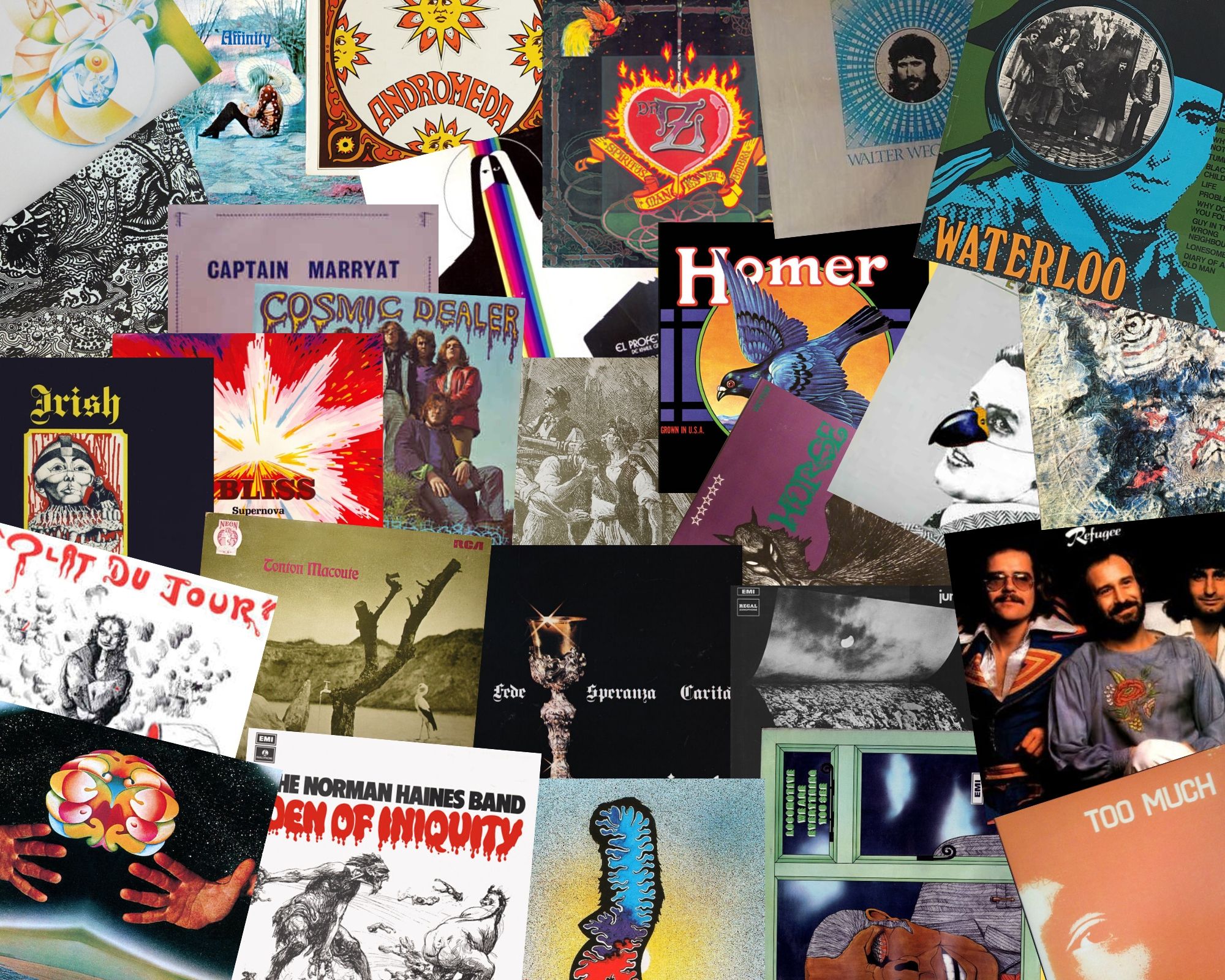
Homer – Grown in U.S.A.
[Universal Recording Artists, 1972]
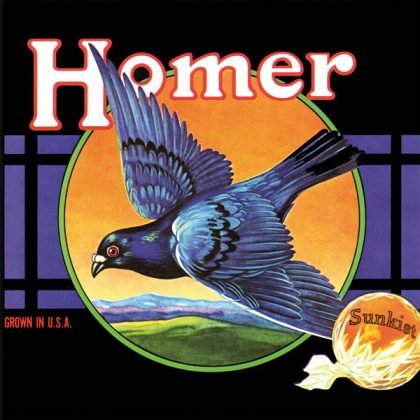 After releasing three 45’s purely psychedelic in nature, Homer (hailing from San Antonio) developed and enriched their sound with heavy and progressive elements and they released their sole album Grown in U.S.A. in 1970. Although it is far from a masterpiece, it is a representative document of the late 60s/early 70s scene and a well-hidden gem for the fans of this particular sound. Balancing beautifully between psychedelia and prog, Homer use the twin guitars and double vocals as a vehicle to offer us inspired compositions, like the heavy-as-needed Survivor and Love’s Coming, the psych Taking My Home and In the Beginning which smell America from a mile, but –above all- the melodic work of art Four Days And Nights ‘Without You’ (fans of Uriah Heep pay attention to this one) and the epic that opens the album Circles in the North which uses the mellotron as a carpet and could fit in any psych/prog collection. Sadly, after their split no member joined any other band or played with other artists. Prior to Homer, the guitarist Galen Niles was a member of a garage/psych band The Outcasts and the bassist Chet Himes became a sound engineer who was awarded also a Grammy for Christopher Cross’s self-titled album.
After releasing three 45’s purely psychedelic in nature, Homer (hailing from San Antonio) developed and enriched their sound with heavy and progressive elements and they released their sole album Grown in U.S.A. in 1970. Although it is far from a masterpiece, it is a representative document of the late 60s/early 70s scene and a well-hidden gem for the fans of this particular sound. Balancing beautifully between psychedelia and prog, Homer use the twin guitars and double vocals as a vehicle to offer us inspired compositions, like the heavy-as-needed Survivor and Love’s Coming, the psych Taking My Home and In the Beginning which smell America from a mile, but –above all- the melodic work of art Four Days And Nights ‘Without You’ (fans of Uriah Heep pay attention to this one) and the epic that opens the album Circles in the North which uses the mellotron as a carpet and could fit in any psych/prog collection. Sadly, after their split no member joined any other band or played with other artists. Prior to Homer, the guitarist Galen Niles was a member of a garage/psych band The Outcasts and the bassist Chet Himes became a sound engineer who was awarded also a Grammy for Christopher Cross’s self-titled album.
Cosmic Dealer – Crystallization
[Negram, 1972]
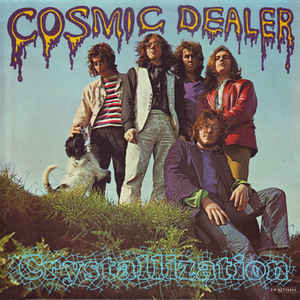 Cosmic Dealer were formed in the Netherlands in 1968 and after a protracted gap they finally released their debut album in 1972. This delay seems it had an impact on the music we hear on Crystallization which is a highly interesting amalgam of musical currents that made their appearance these four years. The bedrock of their music is clearly psychedelic rock, pretty much like the initial intention of the musicians judging by their monicker. Nevertheless, progressive rock has been incorporated into their sound in a very peculiar and unique fashion. A heavy element permeates several songs, too. The band is in the pocket and the sound is really good. The most remarkable thing is the variety of the compositions, but also the arrangement options they went for, with flute and string instruments thrown in. The way they absorbed and assimilated the music from Britain and the USA was very successful and peculiar. Of course, the trump card of Crystallization is the compositions themselves as well as its awesome flow which classify it as one of the most enjoyable obscure gems of the 70s and one of the best Dutch rock albums. Three more tracks were recorded in 1973 before the band split and they can be found on the compilation Child of Tomorrow.
Cosmic Dealer were formed in the Netherlands in 1968 and after a protracted gap they finally released their debut album in 1972. This delay seems it had an impact on the music we hear on Crystallization which is a highly interesting amalgam of musical currents that made their appearance these four years. The bedrock of their music is clearly psychedelic rock, pretty much like the initial intention of the musicians judging by their monicker. Nevertheless, progressive rock has been incorporated into their sound in a very peculiar and unique fashion. A heavy element permeates several songs, too. The band is in the pocket and the sound is really good. The most remarkable thing is the variety of the compositions, but also the arrangement options they went for, with flute and string instruments thrown in. The way they absorbed and assimilated the music from Britain and the USA was very successful and peculiar. Of course, the trump card of Crystallization is the compositions themselves as well as its awesome flow which classify it as one of the most enjoyable obscure gems of the 70s and one of the best Dutch rock albums. Three more tracks were recorded in 1973 before the band split and they can be found on the compilation Child of Tomorrow.
Locomotive – We Are Everything You See
[Parlophone, 1970]
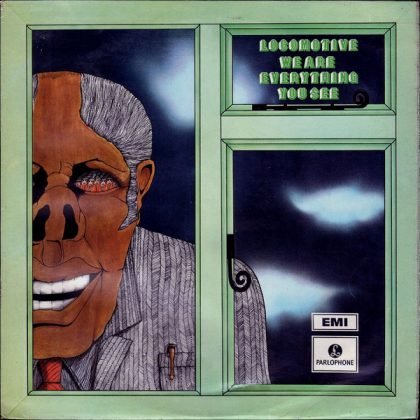 Locomotive was formed in 1965 by Norman Haines. Another founding member and the manager of the band was trumpeter Jim Simpson, who also represented their fellow citizens Black Sabbath. We Are Everything You See was recorded in late 1968 at the legendary Abbey Road Studios but was not released before February 1st, 1970 (just 12 days before Black Sabbath’s debut), when pop / rock music had already changed significantly.
Locomotive was formed in 1965 by Norman Haines. Another founding member and the manager of the band was trumpeter Jim Simpson, who also represented their fellow citizens Black Sabbath. We Are Everything You See was recorded in late 1968 at the legendary Abbey Road Studios but was not released before February 1st, 1970 (just 12 days before Black Sabbath’s debut), when pop / rock music had already changed significantly.
The music is a mix of British psychedelia, early progressive rock with jazz and even soul elements with lots of wind instruments (three saxophonists are involved – including Dick Heckstall-Smith – and two trumpeters) with complete absence of guitar. The wonderful Mr. Armageddon is one of the absolute highlights of English psychedelic rock, but was too dark both musically and lyrically to become a success. The music and historical significance of the album was recognized several years later, when it was re-released.
Shortly after the release, Locomotive disbanded and some of the members formed Norman Haines Band and Dog That Bit People (both with a single album released in 1971). Mick Hincks became a member of Tea and Symphony, Robert Lamb formed The System in the 80s, while Chris Wood was in the original quartet of another band from Birmingham. Their name: Traffic.
Fantasia – Fantasia
[Hi-Hat, 1975]
 Fantasia was formed in 1973 in the small town of Pietarsaari on the west coast of Finland out of the ashes of St.Marcus Blues Band, with Hannu Lindblom (guitar, vocals) and Karl-Erik Rönngård (drums) as leaders. Their name came from the Amazing Blondel’s Fantasia Lindum album (1971) and in 1974 they won the first prize in the national Finnish Rock Championship, which gave them a contract with Hi-Hat, a company that also signed Kalevala that era.
Fantasia was formed in 1973 in the small town of Pietarsaari on the west coast of Finland out of the ashes of St.Marcus Blues Band, with Hannu Lindblom (guitar, vocals) and Karl-Erik Rönngård (drums) as leaders. Their name came from the Amazing Blondel’s Fantasia Lindum album (1971) and in 1974 they won the first prize in the national Finnish Rock Championship, which gave them a contract with Hi-Hat, a company that also signed Kalevala that era.
Ase, Pekka Pöyry of Tasavallan Presidentti plays saxophone, while the production was carried out by Mikael Wiik (Maru & Mikael) and Ronnie Österberg (then member of Wigwam) was the drummer. Although the music has clear influences from Wigwam’s jazzy sound, Fantasia’s main musical direction was basically melodic, atmospheric symphonic progressive rock. The tracks are mostly instrumental, an area in which the band was quite impressive in contrast to Lindblom’s vocals.
The album sold only 2,000 copies and Hi-Hat did not give the band a chance to record a second album. Between 1976 and 1978 there were many personnel changes and finally they disbanded in 1979 and almost all of them quit playing music, except for Rönngård.
Plat Du Jour – Plat Du Jour
[Speedball, 1977]
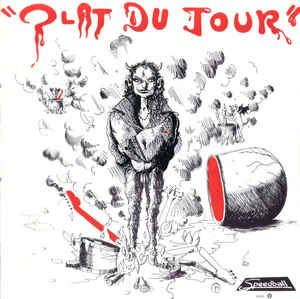 Little is known about this obscure French band. They were based just outside Rouen and their existence was short (1974-1977) with their only album being released by the also short-lived Speedball. The only member who had ever recorded anything was Alain Potier (he had participated in François Ovide’s So & Co), who participated in the Plat Du Jour album as a guest musician.
Little is known about this obscure French band. They were based just outside Rouen and their existence was short (1974-1977) with their only album being released by the also short-lived Speedball. The only member who had ever recorded anything was Alain Potier (he had participated in François Ovide’s So & Co), who participated in the Plat Du Jour album as a guest musician.
Although this was a hardcore underground band, the music mix of Plat Du Jour was not by any means immature. However, it was obscure and was intended for tutored ears and quite specific music tastes. This is a peculiar and very interesting version of incompatible experimental jazz-rock / avant-prog / progressive rock with psychedelic spots with fuzz organ and spacey passages. The excellent technical background of the members, the obvious live jamming character in such demanding themes and the sufficiently extreme performance deserve the respect of every fan of underground 70s music, especially those who prefer its darker side, a typical characteristic of the French prog scene of the time.
Plat Du Jour’s only album remained in obscurity until its re-release in 2016 by Mellotron Records on vinyl and by Paisley Press on cd.
Life – Life
[Columbia, 1970]
 Life was a power trio, formed in 1970 in Stockholm. Two members came from the wonderful King George Discovery who played psych / soul / blues rock. During the same year, their self-titled album was released. If we try to put our finger on some influences, we’ll find traces of Tear Gas or Leaf Hound. The result is an explosive mix of hard sound with strong psych / prog elements. Bearing in mind that this is the debut album of the trio, it sounds mature and quite original. Smart killer guitars, dynamic drums that fill and very filling bass lines form the line of fire. Hard blues rock coexists harmoniously with progressive sound, while upon the second or third hearing we can spot some soft symphonic elements in complete balance with the presence of the piano and the organ.
Life was a power trio, formed in 1970 in Stockholm. Two members came from the wonderful King George Discovery who played psych / soul / blues rock. During the same year, their self-titled album was released. If we try to put our finger on some influences, we’ll find traces of Tear Gas or Leaf Hound. The result is an explosive mix of hard sound with strong psych / prog elements. Bearing in mind that this is the debut album of the trio, it sounds mature and quite original. Smart killer guitars, dynamic drums that fill and very filling bass lines form the line of fire. Hard blues rock coexists harmoniously with progressive sound, while upon the second or third hearing we can spot some soft symphonic elements in complete balance with the presence of the piano and the organ.
Although the album was released in Swedish for commercial reasons, it was released the following year with lyrics sang in English. Songs such as Sailing in the Sunshine, Many Years Ago, Living is Loving and One of Us characterize the atmosphere and musical search in the early ‘70s. Life disbanded in the August of 1972 and after that the members played in Stockholm bands such as Nature, Resan and Butter Lyss.
Junior’s Eyes – Battersea Power Station
[Regal Zonophone, 1969]
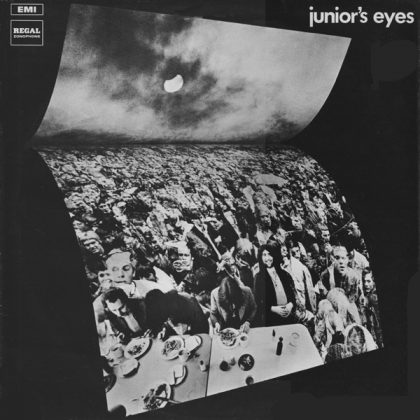 After changing many bands, guitarist and singer Mick Wayne formed Junior’s Eyes in 1968. Their debut, which was also meant to be their swan song, was released in June 1969 under the title Battersea Power Station, which refers to the power energy station which was photographed for the cover of Pink Floyd’s Animals. That same month, Mick Wayne and Rick Wakeman – who plays keyboards on the album – participated in David Bowie’s Space Oddity recordings, along with bassist Honk, who later took part in the recordings for Twink’s legendary Think Pink (1970). These activities somewhat distracted Junior’s Eyes, who opened a Bowie gig on February 3rd, 1970, after which he was introduced to Mick Ronson.
After changing many bands, guitarist and singer Mick Wayne formed Junior’s Eyes in 1968. Their debut, which was also meant to be their swan song, was released in June 1969 under the title Battersea Power Station, which refers to the power energy station which was photographed for the cover of Pink Floyd’s Animals. That same month, Mick Wayne and Rick Wakeman – who plays keyboards on the album – participated in David Bowie’s Space Oddity recordings, along with bassist Honk, who later took part in the recordings for Twink’s legendary Think Pink (1970). These activities somewhat distracted Junior’s Eyes, who opened a Bowie gig on February 3rd, 1970, after which he was introduced to Mick Ronson.
The music at Battersea Power Station is a peculiar mix of psychedelic and early progressive rock with a partially singer-songwriter approach and emphasis on composition rather than on playing, which however is enjoyable in tracks like Imagination and White Light. After Junior’s Eyes disbanded in 1970, Honk and Renwick formed Quiver and the latter later played with Mike + The Mechanics, Roger Waters and Floyd (after Waters had left the band).
Captain Marryat – Captain Marryat
[Thor Records, 1974]
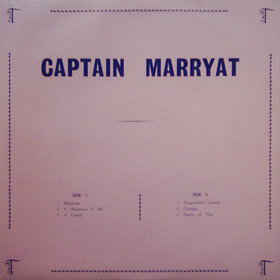 The quarter from Scotland was an active group with regular shows at local clubs. The band members never had any aspirations to record an album despite the fact that there was already enough material available due to their reserved stance. The exhortations of an employee who was working at a studio in Glasgow changed their mind and the final result justified his persistence in spades. The few hundred copies of their self-titled debut album that came out in 1974 were purchased by their following at their gigs. Their style is an eclectic mixture of proto-prog, early 70s prog and hard rock with fuzzy guitars and the sophisticated usage of Hammond. The sound nods clearly to the very early 70s, no matter if the album came out halfway the 70s. No composition falls short, each and every one is magnificent and at times they bring Uriah Heep and their fellow-citizens Beggars Opera effortlessly to mind. Spirited jam mood (Dance of Thor), sparkling, emerald elegies (Blindness, A Friend) compositions that transmit on psychedelic frequencies (It Happened to Me), poetic and heavy disposition (Songwriter’s Lament) and direct 60s references (Changes). Unfortunately, history fails to show, now that everything is said and done, if Captain Marryat were a wasted chance or not.
The quarter from Scotland was an active group with regular shows at local clubs. The band members never had any aspirations to record an album despite the fact that there was already enough material available due to their reserved stance. The exhortations of an employee who was working at a studio in Glasgow changed their mind and the final result justified his persistence in spades. The few hundred copies of their self-titled debut album that came out in 1974 were purchased by their following at their gigs. Their style is an eclectic mixture of proto-prog, early 70s prog and hard rock with fuzzy guitars and the sophisticated usage of Hammond. The sound nods clearly to the very early 70s, no matter if the album came out halfway the 70s. No composition falls short, each and every one is magnificent and at times they bring Uriah Heep and their fellow-citizens Beggars Opera effortlessly to mind. Spirited jam mood (Dance of Thor), sparkling, emerald elegies (Blindness, A Friend) compositions that transmit on psychedelic frequencies (It Happened to Me), poetic and heavy disposition (Songwriter’s Lament) and direct 60s references (Changes). Unfortunately, history fails to show, now that everything is said and done, if Captain Marryat were a wasted chance or not.
Arzachel – Arzachel
[Evolution, 1969]
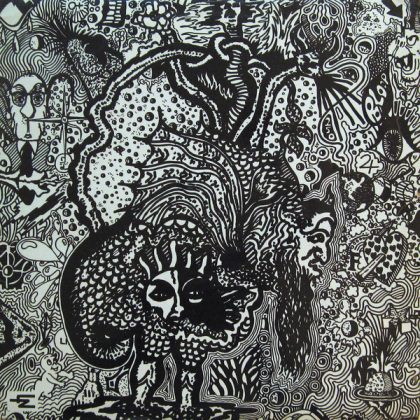 As 1967 was coming to a close, three friends – classmates at City of School London (Steve Hillage, Dave Stewart and Mont Campell) decided to realize their dream. With the drummer Clive Brooks on board and wrapped up in the spirit of Cream, Jimi Hendrix Experience, Nice, Sgt. Peppers of Beatles, The Piper at the Gates of Dawn of Floyd, as well as the blues teachings of Muddy Waters and the Bluesmakers, they formed Uriel. In the middle of 1968 Hillage stepped down to attend his studies and the three remaining members changed the band’s name to Egg. The potential guitar hero Hillage decided to return to the fold and due to an unexpected proposal from a poxy label to put together a short-lived psychedelic project, the band resumed its former configuration under the name of Arzachel. The outcome of this was an overwhelming acid/blues/psychedelic/prog album that came out in 1969. Arzachel is as pioneering as an album could be at the time, eccentric, odd and dark, which takes the listener either to the inner sanctum of dissonant improvisations or to prototypical Canterbury endings. Had they kept going, it is more than likely that they would follow the vision of a myriad of bands whose members had starring or co-starring role, from Egg to Hatfield & the North and National Health and from Khan to Gong.
As 1967 was coming to a close, three friends – classmates at City of School London (Steve Hillage, Dave Stewart and Mont Campell) decided to realize their dream. With the drummer Clive Brooks on board and wrapped up in the spirit of Cream, Jimi Hendrix Experience, Nice, Sgt. Peppers of Beatles, The Piper at the Gates of Dawn of Floyd, as well as the blues teachings of Muddy Waters and the Bluesmakers, they formed Uriel. In the middle of 1968 Hillage stepped down to attend his studies and the three remaining members changed the band’s name to Egg. The potential guitar hero Hillage decided to return to the fold and due to an unexpected proposal from a poxy label to put together a short-lived psychedelic project, the band resumed its former configuration under the name of Arzachel. The outcome of this was an overwhelming acid/blues/psychedelic/prog album that came out in 1969. Arzachel is as pioneering as an album could be at the time, eccentric, odd and dark, which takes the listener either to the inner sanctum of dissonant improvisations or to prototypical Canterbury endings. Had they kept going, it is more than likely that they would follow the vision of a myriad of bands whose members had starring or co-starring role, from Egg to Hatfield & the North and National Health and from Khan to Gong.
J.E.T. – Fede Speranza Carità
[Durium, 1972]
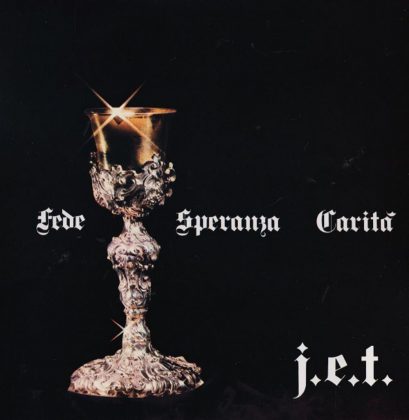 J.E.T. was formed in 1971 in Genoa. Their sole album is a perfect example of the evolution of the progressive sound with strong symphonic elements. What makes it stand out is the unique impression it leaves after every hearing, due to the heavy guitars, the rich organ sound and the drums that create many variations in the rhythmic base. The album starts off with two prog epics, Fede Speranza Carità and Il Prete E Il Peccatore that characterize the sound of the band throughout the abum. The most distinctive element of the album is the sound variety. Here, heavy prog may bring Museo Rosenbach and Il Baletto di Bronzo to mind, but the distortion is very high, while there are distictive jazz and folk elements and maintaining a wonderful underground aura.
J.E.T. was formed in 1971 in Genoa. Their sole album is a perfect example of the evolution of the progressive sound with strong symphonic elements. What makes it stand out is the unique impression it leaves after every hearing, due to the heavy guitars, the rich organ sound and the drums that create many variations in the rhythmic base. The album starts off with two prog epics, Fede Speranza Carità and Il Prete E Il Peccatore that characterize the sound of the band throughout the abum. The most distinctive element of the album is the sound variety. Here, heavy prog may bring Museo Rosenbach and Il Baletto di Bronzo to mind, but the distortion is very high, while there are distictive jazz and folk elements and maintaining a wonderful underground aura.
Combining the cover art with the originality of the musical content, Fede Speranza Carità is rightfully considered by many to be the “holy grail” of Rock Progressivo Italiano with which J.E.T. left their mark in the first years of the 70s and still sound original to this day.
Three of the four members formed the pop band Matia Bazar in 1975, while drummer Renzo Cochis participated in the recordings of Picchio Dal Pozzo’s first album.
Univeria Zekt – The Unnamables
[Thélème, 1972]
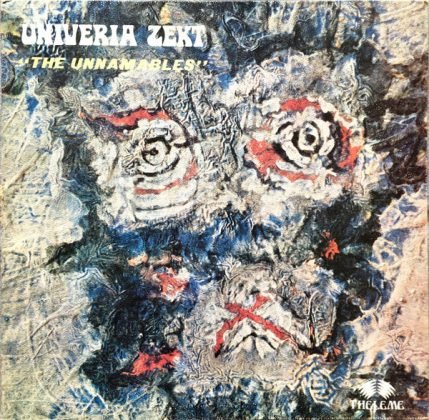 Following the release of Magma’s second album (1001° Centigrades – 1971), the legendary pioneering band sought access to a wider audience. So, with only one lineup change, they decided to release an album with the lyrics in English. For this reason, the album was not released under the name Magma but as Univeria Zekt with the obviously self-sarcastic title The Unnamables, in January 1972.
Following the release of Magma’s second album (1001° Centigrades – 1971), the legendary pioneering band sought access to a wider audience. So, with only one lineup change, they decided to release an album with the lyrics in English. For this reason, the album was not released under the name Magma but as Univeria Zekt with the obviously self-sarcastic title The Unnamables, in January 1972.
Another very interesting thing about The Unnamables is that the two sides of the album have almost nothing to do with each other. On the first side, the compositions of Teddy Lasry, Francois Cahen and Lucien “Zabu” Zabuski are quite groovy and accessible jazz-rock / prog for the standards of the band with English lyrics. In contrast, the three tracks on the side B are compositions of the leader Christian Vander and are essentially pure Magma music, in the characteristic experimental zeuhl spirit, while in Undia, the track that closes the album, the lyrics are in Kobaïan.
The fact that Univeria Zekt was a short-lived project gave this album mythical dimensions in the minds of friends of Magma music. However, Magma experienced success and universal recognition in the most unexpected way: the highly unconventional Mekanïk Destruktïw Kommandöh which was released a year later.
Too Much – Too Much
[Atlantic, 1971]
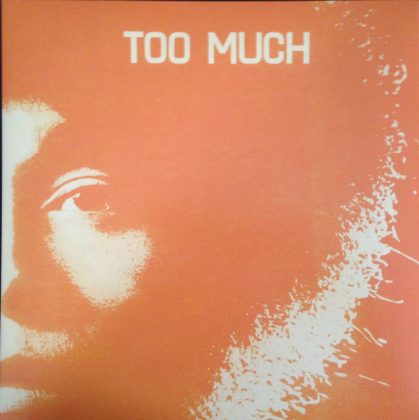 Too Much hailed from Kobe and was one of the many Japanese bands that released only one album during the ‘70s. After signing a deal with Atlantic Records, the four band members entered the studio and recorded their self-titled debut. Musically, the album is a strong mix of heavy psych, blues rock and early progressive rock. The songwriting is very good and the band did a solid job with their instruments. The whole material has excellent production and it is very well balanced and consistent without any fillers. It is even hard to choose a highlight, but for me it’s the closing track, Song for my Lady. It’s a hauntingly beautiful epic progressive piece mainly influenced by King Crimson. It is not far-fetched to say that it could even have been included in In the Court of the Crimson King without ruining the overall quality of the legendary album. Another interesting fact about the record is that the famous Japanese composer Tomita did string arrangements on it. Undoubtedly, Too Much demonstrated a great potential on this release, but it seems that it wasn’t enough for a bigger support from the record company and breakthrough to the wider audiences, so the band split soon after the album was released.
Too Much hailed from Kobe and was one of the many Japanese bands that released only one album during the ‘70s. After signing a deal with Atlantic Records, the four band members entered the studio and recorded their self-titled debut. Musically, the album is a strong mix of heavy psych, blues rock and early progressive rock. The songwriting is very good and the band did a solid job with their instruments. The whole material has excellent production and it is very well balanced and consistent without any fillers. It is even hard to choose a highlight, but for me it’s the closing track, Song for my Lady. It’s a hauntingly beautiful epic progressive piece mainly influenced by King Crimson. It is not far-fetched to say that it could even have been included in In the Court of the Crimson King without ruining the overall quality of the legendary album. Another interesting fact about the record is that the famous Japanese composer Tomita did string arrangements on it. Undoubtedly, Too Much demonstrated a great potential on this release, but it seems that it wasn’t enough for a bigger support from the record company and breakthrough to the wider audiences, so the band split soon after the album was released.
Touch – Touch
[Deram / Coliseum, 1969]
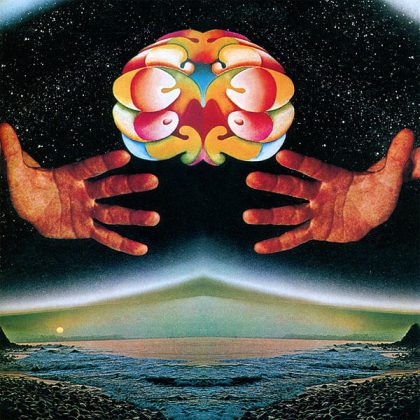 The British psychedelic scene of the 60s was, undoubtedly, the matrix of progressive rock which flourished in the 70s. On the other side of the pond, this transition never occurred and only a handful of musicians, mostly underground, picked up on that. In the light of this, the sole album of Touch should come as a paradox for the American psychedelic rock. Touch had the potential, mutatis mutandis, to become the American Moody Blues, had they went on. The disposition to experimentation, the long songs, the style of the melodies but, above all, the structure of the compositions put the album in the early, pre In the Court of the Crimson King progressive rock attempts. All the compositions are based on the above principles, but special mention should be made of the two longer compositions, Seventy Five and the monumental The Spiritual Death Of Howard Greer, one of the most important early prog epics. That bands like Yes, Uriah Heep and Kansas cite the album of Touch as an influence is not a coincidence and it is a testimony of the album’s value. The refusal of the keyboard player and leader Don Gallucci to tour in order to promote the album, holding the view that it was impossible to reproduce the album on stage, marked the end of Touch. Himself, studio-freak indeed, he got into production.
The British psychedelic scene of the 60s was, undoubtedly, the matrix of progressive rock which flourished in the 70s. On the other side of the pond, this transition never occurred and only a handful of musicians, mostly underground, picked up on that. In the light of this, the sole album of Touch should come as a paradox for the American psychedelic rock. Touch had the potential, mutatis mutandis, to become the American Moody Blues, had they went on. The disposition to experimentation, the long songs, the style of the melodies but, above all, the structure of the compositions put the album in the early, pre In the Court of the Crimson King progressive rock attempts. All the compositions are based on the above principles, but special mention should be made of the two longer compositions, Seventy Five and the monumental The Spiritual Death Of Howard Greer, one of the most important early prog epics. That bands like Yes, Uriah Heep and Kansas cite the album of Touch as an influence is not a coincidence and it is a testimony of the album’s value. The refusal of the keyboard player and leader Don Gallucci to tour in order to promote the album, holding the view that it was impossible to reproduce the album on stage, marked the end of Touch. Himself, studio-freak indeed, he got into production.
The Norman Haines Band – Den of Iniquity
[Parlophone, 1971]
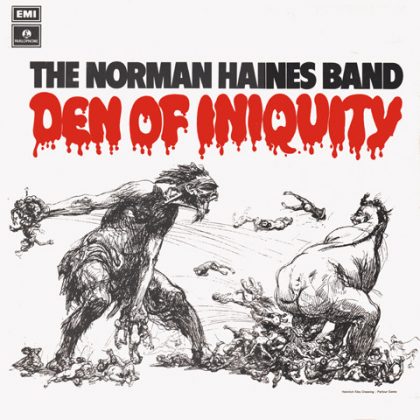 After the release of We Are Everything You See and the split of Locomotive, the keyboardist Norman Haines decided to form his own band and without further ado he put out a mere year later the album Den of Iniquity. Compared to the particular prog/psych style of Locomotive which featured tons of wind instruments and keyboards, Norman Haines Band took a clearly heavy/prog direction which was basically organ- and guitar-driven. The first side of the vinyl unravels a variety of influences and moods, for instance the self-titled opener and When I Come Down which are representative cuts of the new direction we spoke of, Finding My Way and the re-make of Mr. Armageddon of Locomotive (equally good, to say the least) maintain shreds of their psychedelic past and finally the killer folk track Bourgeois. The second side of the vinyl greets us with the 13-minute Rabbits which begins and ends with a heavy/blues theme while in between the listener is confronted with a hellish prog jam. The out-there keyboard instrumental Life Is So Kind that closes the album could be arguably held as one of the heavy/prog highlights of the early 1970s British scene.
After the release of We Are Everything You See and the split of Locomotive, the keyboardist Norman Haines decided to form his own band and without further ado he put out a mere year later the album Den of Iniquity. Compared to the particular prog/psych style of Locomotive which featured tons of wind instruments and keyboards, Norman Haines Band took a clearly heavy/prog direction which was basically organ- and guitar-driven. The first side of the vinyl unravels a variety of influences and moods, for instance the self-titled opener and When I Come Down which are representative cuts of the new direction we spoke of, Finding My Way and the re-make of Mr. Armageddon of Locomotive (equally good, to say the least) maintain shreds of their psychedelic past and finally the killer folk track Bourgeois. The second side of the vinyl greets us with the 13-minute Rabbits which begins and ends with a heavy/blues theme while in between the listener is confronted with a hellish prog jam. The out-there keyboard instrumental Life Is So Kind that closes the album could be arguably held as one of the heavy/prog highlights of the early 1970s British scene.
Kestrel – Kestrel
[Cube Records, 1975]
 Kestrel was a group of the second wave of progressive rock in the mid-1970s formed in Newcastle in 1975 that sadly disbanded just a year later. That’s because the sales of their only album didn’t go well at all, and producer John Worth’s efforts to promote them ultimately did not pay off.
Kestrel was a group of the second wave of progressive rock in the mid-1970s formed in Newcastle in 1975 that sadly disbanded just a year later. That’s because the sales of their only album didn’t go well at all, and producer John Worth’s efforts to promote them ultimately did not pay off.
Musically, it is a very special mix of very melodic symphonic progressive rock with poppy vocal melodies, very beautiful keys but also very intense and good guitar playing. Without impressing much, the compositional level is at a satisfactory level from beginning to end, but the elements that impress mostly are the level of technique, the stunning production and the very personal style, which is also reflected in the album cover. Aside from the cult status of such a special release, Kestrel is considered by many as an unpretentious example of high aesthetics progressive rock.
After the disbandment of Kestrel, guitarist Dave Black, who wrote most of the tracks on the album, joined Spiders From Mars and replaced Mick Ronson. The original vinyl version of Kestrel’s album by Cube Records today is worth up to €2,500.
Horse – Horse
[RCA Victor, 1971]
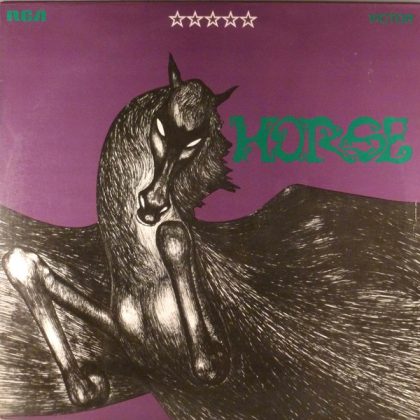 The British Horse released their one and only album in 1970 which was meant to become a kind of “Holy Grail” for the collectors of heavy prog / psychedelic sound. A few years ago, Rise Above put out an amazing re-issue of the album with bonus tracks and it was sold out fairly quickly.
The British Horse released their one and only album in 1970 which was meant to become a kind of “Holy Grail” for the collectors of heavy prog / psychedelic sound. A few years ago, Rise Above put out an amazing re-issue of the album with bonus tracks and it was sold out fairly quickly.
The quartet, whose members had working experience under their belt by playing in obscure bands like Andromeda, delivers on its debut album all-out heavy rock with prog and psychedelic dashes, as well as particularly intense heavy/blues elements. The strong guitars and perpetual solos, but also the superb drumming are surely the top elements that put together this album and some short psychedelic blues masterpieces (And I Have Loved You) are also included which could perfectly fit in Fleetwood Mac’s Then Play On.
What takes the album to the next level is the palpable passion of the musicians which oozes throughout the entire album. Some members found their way by participating in other household artists like Wings (Paul McCartney) Elton John, Joe Cocker and Atomic Rooster, but the question of how far could Horse go still remains; perhaps further and higher than they thought they could.
Armando Tirelli – El Profeta
[SEM Label, 1978]
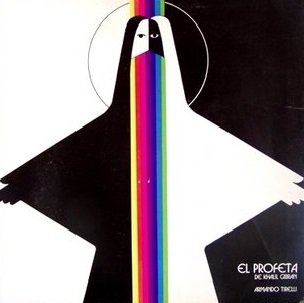 The main reason there were so few rock music releases from Uruguay in the 1970s is not the small population of the country (less than 3 million at the time), but the military dictatorship that ruled the country from 1973-85.
The main reason there were so few rock music releases from Uruguay in the 1970s is not the small population of the country (less than 3 million at the time), but the military dictatorship that ruled the country from 1973-85.
Keyboardist Armando Tirelli was a member of Sexteto Electrónico Moderno lounge band and psych pop Mexican band Exodo and in 1973 began working on an ambitious solo project, which was released five years later. El Profeta was a concept album based on the book The Poetry (1923), a collection of 26 prose poems written by the Lebanese-American author Kahlil Gibran.
The album is basically a melodic symphonic progressive rock release that sounds -not accedentally- pretty much like the Italian 70s prog rock scene. As one might assume, Tirelli’s exceptional piano and keys playing is dominant, and even though the sound is bad, it gives a strong underground feel to El Profeta. G. Bregstein’s flute is also impressive, as is the narration by Uruguayan actor Roberto Fontana.
This is the most cult album of all that are presented in this article. Time may have been cruel to El Profeta, but this intensifies the nostalgia for an era that musically ended in the twilight of the 70s.
Refugee – Refugee
[Charisma, 1974]
 Refugee is one of the most important and historically overlooked supergroups of the 70s, even though when the band was formed (1973) it included three very well-known musicians. Brian Davison (drums, percussion) and Lee Jackson (bass, cello, guitar, vocals) were members of the highly innovative The Nice, who along with the late great Keith Emerson released prophetic records such as The Thoughts of Emerlist Davjack (1967) and Ars Longa Vita Brevis (1968). After they disbanded, Jackson formed Jackson Heights (the 1970 King Progress is an excellent example of early British prog rock). In 1973, looking for a new keyboardist for his band, he approached the Swiss virtuoso Patrick Moraz (ex-Mainhorse) who suggested that they should do something from scratch. Davison was the obvious choice and the three of them spent eight hours a day in the studio, working on their new material. The tracks were recorded at Island studios with Jackson writing the lyrics and Moraz composing the music. The latter is evident throughout the album, which is characterized as highly technical symphonic progressive rock with two very long prog epics (Grand Canyon, Credo). Shortly after the release, Refugee toured to promote the album, but fatally disbanded in August 1974 when Yes asked Moraz to replace Rick Wakeman.
Refugee is one of the most important and historically overlooked supergroups of the 70s, even though when the band was formed (1973) it included three very well-known musicians. Brian Davison (drums, percussion) and Lee Jackson (bass, cello, guitar, vocals) were members of the highly innovative The Nice, who along with the late great Keith Emerson released prophetic records such as The Thoughts of Emerlist Davjack (1967) and Ars Longa Vita Brevis (1968). After they disbanded, Jackson formed Jackson Heights (the 1970 King Progress is an excellent example of early British prog rock). In 1973, looking for a new keyboardist for his band, he approached the Swiss virtuoso Patrick Moraz (ex-Mainhorse) who suggested that they should do something from scratch. Davison was the obvious choice and the three of them spent eight hours a day in the studio, working on their new material. The tracks were recorded at Island studios with Jackson writing the lyrics and Moraz composing the music. The latter is evident throughout the album, which is characterized as highly technical symphonic progressive rock with two very long prog epics (Grand Canyon, Credo). Shortly after the release, Refugee toured to promote the album, but fatally disbanded in August 1974 when Yes asked Moraz to replace Rick Wakeman.
Waterloo – First Battle
[Disques Vogue, 1970]
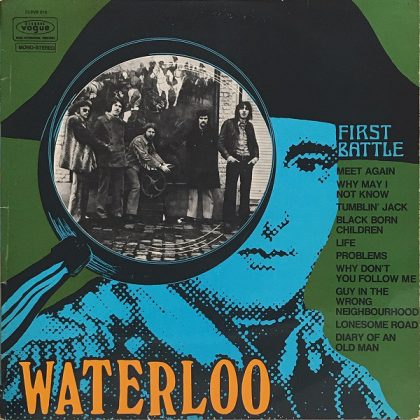 The explosion of rock music in the early 1960s and late 1970s left behind a huge legacy. Even bands that did not belong to the vanguard wrote and performed music of high artistic value. In this context, the sole album of the Belgians Waterloo is of great musical interest aside its historical importance to the Belgian scene. It is an album that bears obvious influences from Great Britain and it is an illuminating example of how the British scene affected the entire Europe. On the nine short compositions plus the finale of Diary of an Old Man, the flutist’s love for Ian Anderson’s playing becomes evident, as well as the aggressive sound of the keyboards in the vein of Keith Emerson. It is remarkable how these influences were absorbed in so little time. The album came out at the dawn of the 1970 and has already absorbed music and sounds which were in a constant, at the speed of light one would say, progress. Sadly, the first battle of Waterloo was also meant to be their last, therefore they did not have the time to develop their own style. They left behind a very good and an historical album for sure, quite heavy and progressive that makes it into the long list of the early proto-prog gems (and the first edition is sold nowadays at preposterous prices).
The explosion of rock music in the early 1960s and late 1970s left behind a huge legacy. Even bands that did not belong to the vanguard wrote and performed music of high artistic value. In this context, the sole album of the Belgians Waterloo is of great musical interest aside its historical importance to the Belgian scene. It is an album that bears obvious influences from Great Britain and it is an illuminating example of how the British scene affected the entire Europe. On the nine short compositions plus the finale of Diary of an Old Man, the flutist’s love for Ian Anderson’s playing becomes evident, as well as the aggressive sound of the keyboards in the vein of Keith Emerson. It is remarkable how these influences were absorbed in so little time. The album came out at the dawn of the 1970 and has already absorbed music and sounds which were in a constant, at the speed of light one would say, progress. Sadly, the first battle of Waterloo was also meant to be their last, therefore they did not have the time to develop their own style. They left behind a very good and an historical album for sure, quite heavy and progressive that makes it into the long list of the early proto-prog gems (and the first edition is sold nowadays at preposterous prices).
Dr. Z – Three Parts to My Soul
[Vertigo, 1971]
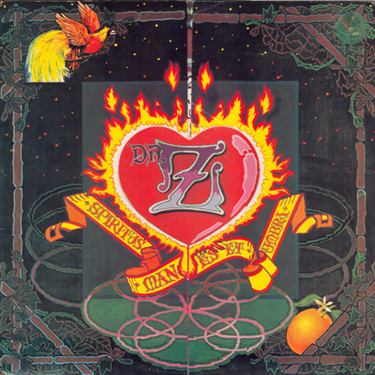 Dr. Z were, in essence, the solo project of the Welsh Keith Meyes with the contribution of two other musicians on the bass and the drums. Their only album was released in 1971 through the legendary Vertigo and rumour had it that at the time a mere 80 copies were sold, some of them set nowadays at preposterous prices.
Dr. Z were, in essence, the solo project of the Welsh Keith Meyes with the contribution of two other musicians on the bass and the drums. Their only album was released in 1971 through the legendary Vertigo and rumour had it that at the time a mere 80 copies were sold, some of them set nowadays at preposterous prices.
Their music falls into the British prog category with intense theatrical elements. The constant usage of the piano and the harpsichord is the most distinctive feature of the songs and provide a classical touch. Guitars are out of the picture, therefore ELP come to mind, only that Dr. Z’s music is not particularly technical. The album’s subtitle (Spiritus, Manes Et Umbra) refers to an occult lyrical concept about soul and afterlife. In this context, the aggressive (almost monolithic) pounding of the drums ties harmonically with the entire endeavor to set a mystical atmosphere.
Three Parts to My Soul is an album worth seeking out, not just because it is a testimony of the diversity of the sounds of the time, but it is also truly interesting. If we factor in the tectonic shift their style underwent in just a year, the question what was next to come becomes all the more intriguing.
Irish Coffee – Irish Coffee
[Triangle, 1971]
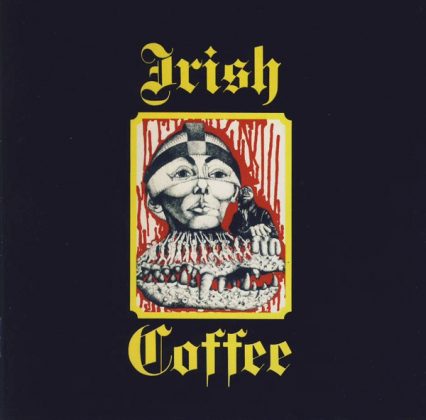 The Flemish Region and Ireland never converged cultural-wise. Nevertheless, to the pioneer of the Belgian scene, William Souffreau, it did happen to some extent. The guitarist/singer we speak of was the spearhead of Irish Coffee, a group that was formed at the dawn of 1970s and completed its brief career in 1975. It came back to the fore in 2002 when they gave some shows and since then they vanished without a trace.
The Flemish Region and Ireland never converged cultural-wise. Nevertheless, to the pioneer of the Belgian scene, William Souffreau, it did happen to some extent. The guitarist/singer we speak of was the spearhead of Irish Coffee, a group that was formed at the dawn of 1970s and completed its brief career in 1975. It came back to the fore in 2002 when they gave some shows and since then they vanished without a trace.
Their self-titled album which came out in 1971 blends primitive hard rockin’ blues, prog rock and British rhythm & blues attractively. The technical abilities of the protagonists are undoubtedly superb, unleashing riffs and solos that convey massive electricity to the listener’s body generating multiple sentimental shocks. Lose yourselves in the exhilarating Hear Me or the stunning and heart-breaking triad of The Beginning of the End, When Winter Comes and A Day Like Today. An album that kicks off with Can’t Take It engages the interest from the outset. The album as a whole makes plain the labour and the sweat that has been poured to give birth to those compositions. The vinyl aficionados enjoy a marvelous re-issue from Guerssen Records since getting hold of the original version is a pipe dream.
Tonton Macoute – Tonton Macoute
[Neon, 1971]
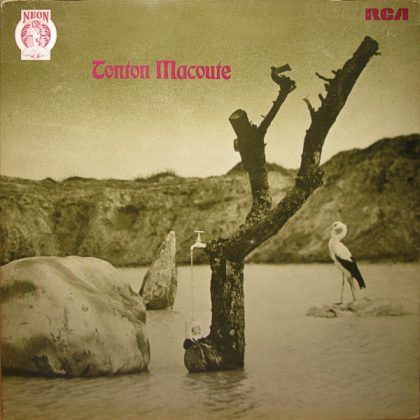 Tonton Macoute rose from the ashes of a poxy pop/rock British group, Windmill, on the heels of the passing of the guitarist Dick Scott. The remaining members decided to soldier on under the same monicker which was probably inspired by John Jenkins’ self-titled album (1970) and they released one album only through Neon. Their style falls into the British jazz-rock category with the intense presence of the saxophone and their prog rock is mainly influenced by jazz. Dave Knowles’ wind instruments (mostly saxophone, but also flute and clarinet) steal the show and define this album. Colours and moods alternate often on the record which is fantastic – no two ways about that. There are also plentiful rhythm changes and shifts in sentiments, the rhythm section provided by Chris Gavin (bass) and Nigel Reveler (drums) is seminal and playful and Paul French does an amazing job on the keyboards. The harmonized voices of French and Knowles add a wondrous tone to the compositions which maintain an intense improvisational character and a melodic aura is ever-present. After they disbanded, French reappeared on Voyager and State of Play and since then he is vanished from the musical fore.
Tonton Macoute rose from the ashes of a poxy pop/rock British group, Windmill, on the heels of the passing of the guitarist Dick Scott. The remaining members decided to soldier on under the same monicker which was probably inspired by John Jenkins’ self-titled album (1970) and they released one album only through Neon. Their style falls into the British jazz-rock category with the intense presence of the saxophone and their prog rock is mainly influenced by jazz. Dave Knowles’ wind instruments (mostly saxophone, but also flute and clarinet) steal the show and define this album. Colours and moods alternate often on the record which is fantastic – no two ways about that. There are also plentiful rhythm changes and shifts in sentiments, the rhythm section provided by Chris Gavin (bass) and Nigel Reveler (drums) is seminal and playful and Paul French does an amazing job on the keyboards. The harmonized voices of French and Knowles add a wondrous tone to the compositions which maintain an intense improvisational character and a melodic aura is ever-present. After they disbanded, French reappeared on Voyager and State of Play and since then he is vanished from the musical fore.
Walter Wegmüller – Tarot
[Die Kosmischen Kuriere / Ohr, 1973]
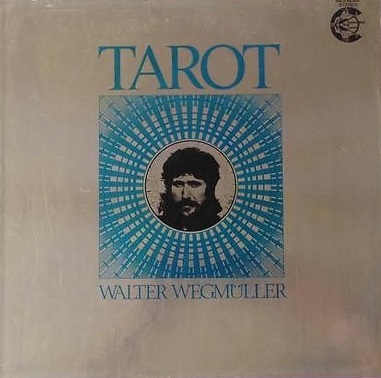 The Swiss painter Walter Wegmüller assembled prominent representatives of assorted Krautrock-currents so that they would develop 22 compositions which would depict in sounds the 22 occult Tarot cards himself designed and enclosed in a box along with two vinyls.
The Swiss painter Walter Wegmüller assembled prominent representatives of assorted Krautrock-currents so that they would develop 22 compositions which would depict in sounds the 22 occult Tarot cards himself designed and enclosed in a box along with two vinyls.
The astral and introspective side was taken over by the electric guitars courtesy of Manuel Göttsching and Harmut Enke from Ash Ra Tempel, whereas the psychotropic, image-inducing folk-side is provided by Walter Westrupp (of the duo Witthüser & Westrupp). The cosmic, electronic respect is purveyed by the versatile Klaus Schulze through keyboards and ritualistic drums. The latter’s bandmates from Wallenstein (Jürgen Dollase and Jerry Berkers) are commissioned to deliver the keyboard and bass parts in that order, unleashing sharp and formidable attacks to all of our senses. Wegmüller sets an imposing psychedelic spoken-word narration while the enterprising producer and musician Dieter Dierks together with Rosi Müller (Ash Ra Tempel) are on the backing vocals.
In this collective treaty, we cannot afford not to mention a later development: all the participants, with the exception of Wegmüller, were involved in long-hour sessions under the influence of LSD which were recorded and distributed by Rolf-Ulrich Kaiser and Kosmischen Kuriereon without their consent on the fascinating string of albums under the monicker of The Cosmic Jokers.
Affinity – Affinity
[Vertigo, 1970]
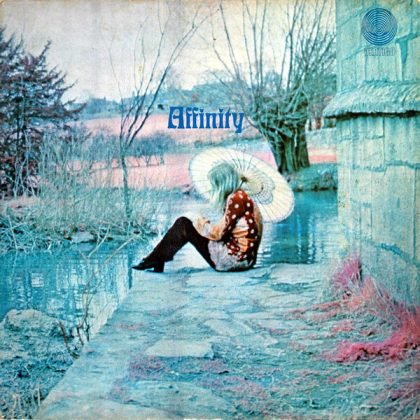 One of the most peculiar musical genres ever, was the British prog/jazz/psych in the early 1970s, especially when it struck a golden medium between the three of them. An illuminating example was Affinity who released their first album at the dawn of the 1970s guided by their rich melodies and the enchanting voice of Linda Hoyle. On I Am and So Are You and Three Sisters we are exposed to Affinity’s stronger side with the wind instruments, the keyboards and the guitar setting the tone, whereas I Wonder If I Care as Much, Mr. Joy and Cocoanut Grove maintain an intensely delicate British aura. One of the summits of the album is Bight Flight with features an acoustic intro, rhythm changes and an unexpected ending that define this spectacular song. For the end they reserved an unbelievable 12-minute remake of the legendary All Along the Watchtower; while keeping the original central melody intact, they pulled off to take it into jazz territories and make it all theirs. Unfortunately, after they disbanded no member engaged into something truly remarkable, excluding the decent solo album of Linda Hoyle entitled Pieces of Me.
One of the most peculiar musical genres ever, was the British prog/jazz/psych in the early 1970s, especially when it struck a golden medium between the three of them. An illuminating example was Affinity who released their first album at the dawn of the 1970s guided by their rich melodies and the enchanting voice of Linda Hoyle. On I Am and So Are You and Three Sisters we are exposed to Affinity’s stronger side with the wind instruments, the keyboards and the guitar setting the tone, whereas I Wonder If I Care as Much, Mr. Joy and Cocoanut Grove maintain an intensely delicate British aura. One of the summits of the album is Bight Flight with features an acoustic intro, rhythm changes and an unexpected ending that define this spectacular song. For the end they reserved an unbelievable 12-minute remake of the legendary All Along the Watchtower; while keeping the original central melody intact, they pulled off to take it into jazz territories and make it all theirs. Unfortunately, after they disbanded no member engaged into something truly remarkable, excluding the decent solo album of Linda Hoyle entitled Pieces of Me.
Andromeda – Andromeda
[RCA Victor, 1969]
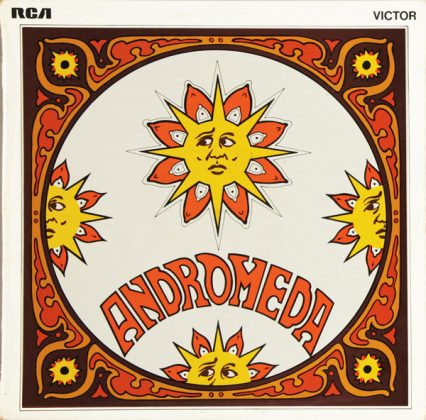 Before he joined Atomic Rooster, John Du Cann led his own band, named Andromeda. The band was founded in 1966 with bassist Mick Hawksworth and drummer Ian McLane. During their activity, the trio released only one studio album in 1969. The album’s content is typical for those times and the music in this album can be described as heavy psychedelic / progressive rock with very guitar-driven sound. Du Cann was in his early twenties but he was already showing off a musical maturity way beyond his age. The highlight of the album is the Sabbathic Return to Sanity which starts with the familiar and powerful sound of Gustav Holst’s Mars from The Planets suite. Other songs worth mentioning are the proggy Turn to Dust as well as the Cream influenced The Reason. Despite the admiration of press and critics, Andromeda did not succeed in the music market. Perhaps the choice of RCA was misguided or maybe they simply lacked a bit of luck to be in the right place at the right time. At least some justice has been done many years after and the album gained an iconic status and is definitely precious jewel for anyone who is into late 60s prog / psych sound.
Before he joined Atomic Rooster, John Du Cann led his own band, named Andromeda. The band was founded in 1966 with bassist Mick Hawksworth and drummer Ian McLane. During their activity, the trio released only one studio album in 1969. The album’s content is typical for those times and the music in this album can be described as heavy psychedelic / progressive rock with very guitar-driven sound. Du Cann was in his early twenties but he was already showing off a musical maturity way beyond his age. The highlight of the album is the Sabbathic Return to Sanity which starts with the familiar and powerful sound of Gustav Holst’s Mars from The Planets suite. Other songs worth mentioning are the proggy Turn to Dust as well as the Cream influenced The Reason. Despite the admiration of press and critics, Andromeda did not succeed in the music market. Perhaps the choice of RCA was misguided or maybe they simply lacked a bit of luck to be in the right place at the right time. At least some justice has been done many years after and the album gained an iconic status and is definitely precious jewel for anyone who is into late 60s prog / psych sound.
Ibliss – Supernova
[Spiegelei / Aamok, 1972]
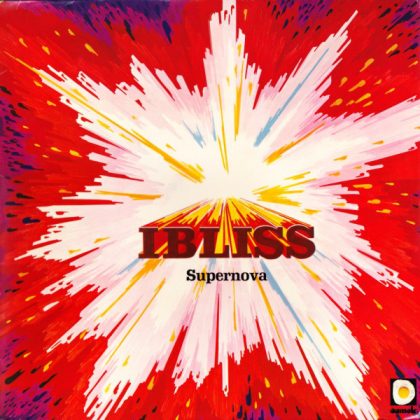 Loosely divided in discernible sonic directions, the krautrock / kosmische musik current has earmarked some links to define each one of these directions. The quintet of Ibliss falls into the jazz/rock category of the genre we speak of, although their lifespan was short and their discography was limited to one album only. The presence of the percussionist/flutist Basil Hammoudi who brought to the table the experience he had earned from his tenure in Organisation, the precursor of Kraftwerk and their one-and-only LP Tone Float (1970), was all-important in this band.
Loosely divided in discernible sonic directions, the krautrock / kosmische musik current has earmarked some links to define each one of these directions. The quintet of Ibliss falls into the jazz/rock category of the genre we speak of, although their lifespan was short and their discography was limited to one album only. The presence of the percussionist/flutist Basil Hammoudi who brought to the table the experience he had earned from his tenure in Organisation, the precursor of Kraftwerk and their one-and-only LP Tone Float (1970), was all-important in this band.
Hailing from Rhenania, they moved to Hamburg to find the appropriate treatment their sound called for in the person of the engineer Conny Plank, a pivotal figure of the underground music. Together, they captured a seismic energy which is largely due to the climaxes induced by the percussion which build pagan-like rituals merging African and Latin aura with an added pinch of Dionysian ecstasy. Besides, they didn’t content themselves with Hammoudi’s drum performance, but they roped in additional musicians to expand on the rhythm game, namely Αndreas Hohmann (percussion), Wolfgang Buellmeyer (percussion and guitar), Norbert Buellmeyer (percussion and bass). The flute and the saxophone which added a psychedelic dash were performed by Rainer Büchel who truly shined. The cyclic patterns of the bass and guitar complement the attractive and groovy flow of the four long compositions of the album.
Bakerloo – Bakerloo
[Harvest, 1969]
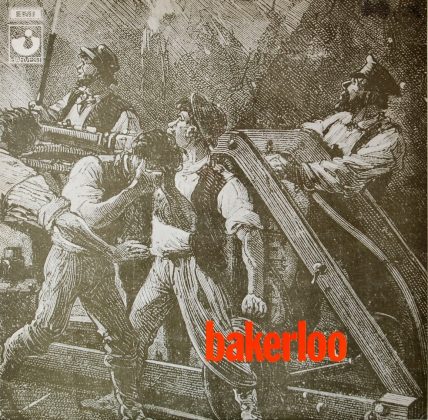 The only and self-titled album of the trio that goes under the name of Bakerloo features blues/rock of high quality with progressive rhythms and mentality, throwing in some heavy elements from time to time. On the instrumental pieces Big Bear Folly and Gang Bang the British perform to their limits and their playing is so energy-consuming and passionate that it is impossible to put it in words. Naturally, the “obligatory” homage to Willie Dixon and Johann Sebastian Bach are in the picture through the renditions of Bring It on Home (the version of Led Zeppelin is familiar to everyone) and Drivin’ Bachwards respectively. The diverse and varied side of Bakerloo is imprinted ideally on Last Blues with its psychedelic passages, as well as on This Worried Feeling which has the stuff of a vintage blues composition but, above all, on the 15-minute epic Son of Moonshine which captures almost everything aforementioned.
The only and self-titled album of the trio that goes under the name of Bakerloo features blues/rock of high quality with progressive rhythms and mentality, throwing in some heavy elements from time to time. On the instrumental pieces Big Bear Folly and Gang Bang the British perform to their limits and their playing is so energy-consuming and passionate that it is impossible to put it in words. Naturally, the “obligatory” homage to Willie Dixon and Johann Sebastian Bach are in the picture through the renditions of Bring It on Home (the version of Led Zeppelin is familiar to everyone) and Drivin’ Bachwards respectively. The diverse and varied side of Bakerloo is imprinted ideally on Last Blues with its psychedelic passages, as well as on This Worried Feeling which has the stuff of a vintage blues composition but, above all, on the 15-minute epic Son of Moonshine which captures almost everything aforementioned.
Bakerloo ‘s career went as far as that, yet it is interesting to know what became of the band members. The guitarist David ‘Clem’ Clemson performed on Colosseum’s Daughter of Time and after that he succeeded Peter Frampton in Humble Pie, the drummer Keith Baker recorded on the monumental Salisbury from Uriah Heep and the bassist Terry Pool teamed up with Graham Bond.
Από τους: Πάρη Γραβουνιώτη, Δημήτρη Καλτσά, Κώστα Μπάρμπα, Πέτρο Παπαδογιάννη, Goran Petrić, Τάσο Ποιμενίδη, Κώστα Ρόκα, Θωμά Σαρακίντση, Παναγιώτη Σταθόπουλο
Μετάφραση: Αλέξανδρος Μαντάς, Δημήτρης Καλτσάς
Η σειρά άρθρων Prog συγκροτήματα με ένα album (1969-1979) είναι μέχρι σήμερα μεταξύ των πιο πολυδιαβασμένων από τους αναγνώστες του Progrocks.gr και είμαστε πολύ χαρούμενοι για αυτό, γιατί κάνουμε ό,τι καλύτερο μπορούμε για να αναδείξουμε όλα τα ιστορικά στοιχεία και την καλλιτεχνική αξία αυτών των -ως επί το πλείστο- παραγνωρισμένων- prog διαμαντιών.
Όπως έγινε στο πρώτο και δεύτερο μέρος, τα “one-album wonders” παρουσιάζονται χωρίς χρονολογική σειρά, αλλά τυχαία και όπως τα δύο πρώτα μέρη, αυτό το άρθρο είναι ένα αδιάκοπο ταξίδι μπρος και πίσω στο χρόνο, που ελπίζουμε να είναι συναρπαστικό στην ανάγνωση όσο ήταν κάθε κομμάτι στη συγγραφή του.

Homer – Grown in U.S.A.
[Universal Recording Artists, 1972]
 Μετά από τρία 45άρια τα οποία κινούνταν σε ξεκάθαρα ψυχεδελικά μονοπάτια, οι Homer με καταγωγή από το San Antonio εξέλιξαν και εμπλούτισαν τον ήχο τους με heavy και progressive στοιχεία και το 1970 κυκλοφόρησαν τον μοναδικό τους δίσκο Grown in U.S.A. Αν και δεν πρόκειται για αριστούργημα, στέκεται ως ένα αντιπροσωπευτικό ντοκουμέντο της σκηνής των late 60s / early 70s και ένα πολύ καλά κρυμμένο μυστικό για τους λάτρεις του συγκεκριμένου ήχου. Ισορροπώντας εξαιρετικά μεταξύ ψυχεδελικού και προοδευτικού ήχου, οι Homer με όχημα τις διπλές κιθάρες και τα διπλά φωνητικά μας προσφέρουν εμπνευσμένες συνθέσεις όπως τα αρκούντως heavy Survivor και Love’s Coming, τα psych Taking My Home, In the Beginning που μυρίζουν Αμερική από χιλιόμετρο, μα πάνω από όλα το μελωδικό κομψοτέχνημα Four Days And Nights ‘Without You’ (οι φίλοι των Uriah Heep ας δώσουν βάση εδώ) αλλά και το εναρκτήριο έπος Circles in the North με το mellotron χαλί που θα μπορούσε να βρίσκεται σε οποιαδήποτε psych / prog συλλογή. Δυστυχώς, μετά τη διάλυσή τους κανένα μέλος τους δεν έπαιξε αλλού. Ο κιθαρίστας Galen Niles πριν τους Homer ήταν μέλος στους garage psych The Outcasts, και ο μπασίστας Chet Himes ακολούθησε καριέρα μηχανικού ήχου κερδίζοντας μάλιστα Grammy για τον ομώνυμο δίσκο του Christopher Cross.
Μετά από τρία 45άρια τα οποία κινούνταν σε ξεκάθαρα ψυχεδελικά μονοπάτια, οι Homer με καταγωγή από το San Antonio εξέλιξαν και εμπλούτισαν τον ήχο τους με heavy και progressive στοιχεία και το 1970 κυκλοφόρησαν τον μοναδικό τους δίσκο Grown in U.S.A. Αν και δεν πρόκειται για αριστούργημα, στέκεται ως ένα αντιπροσωπευτικό ντοκουμέντο της σκηνής των late 60s / early 70s και ένα πολύ καλά κρυμμένο μυστικό για τους λάτρεις του συγκεκριμένου ήχου. Ισορροπώντας εξαιρετικά μεταξύ ψυχεδελικού και προοδευτικού ήχου, οι Homer με όχημα τις διπλές κιθάρες και τα διπλά φωνητικά μας προσφέρουν εμπνευσμένες συνθέσεις όπως τα αρκούντως heavy Survivor και Love’s Coming, τα psych Taking My Home, In the Beginning που μυρίζουν Αμερική από χιλιόμετρο, μα πάνω από όλα το μελωδικό κομψοτέχνημα Four Days And Nights ‘Without You’ (οι φίλοι των Uriah Heep ας δώσουν βάση εδώ) αλλά και το εναρκτήριο έπος Circles in the North με το mellotron χαλί που θα μπορούσε να βρίσκεται σε οποιαδήποτε psych / prog συλλογή. Δυστυχώς, μετά τη διάλυσή τους κανένα μέλος τους δεν έπαιξε αλλού. Ο κιθαρίστας Galen Niles πριν τους Homer ήταν μέλος στους garage psych The Outcasts, και ο μπασίστας Chet Himes ακολούθησε καριέρα μηχανικού ήχου κερδίζοντας μάλιστα Grammy για τον ομώνυμο δίσκο του Christopher Cross.
Cosmic Dealer – Crystallization
[Negram, 1972]
 Οι Cosmic Dealer δημιουργήθηκαν στην Ολλανδία το 1968 και μετά από ένα μεγάλο κενό κυκλοφόρησαν τον πρώτο τους δίσκο το 1972. Αυτή η καθυστέρηση μοιάζει να επηρέασε τη μουσική που ακούμε στο Crystallization, το οποίο αποτελεί ένα πολύ ενδιαφέρον αμάλγαμα μουσικών ρευμάτων που εμφανίστηκαν τα τέσσερα αυτά χρόνια. Η βάση του ήχου είναι ξεκάθαρα το ψυχεδελικό rock, όπως και η αρχική πρόθεση των μουσικών, αν κρίνουμε και από το όνομα της μπάντας. Παρόλα αυτά, το progressive rock έχει ενσωματωθεί στον ήχο τους με ένα πολύ ιδιαίτερο και αρκετά μοναδικό τρόπο. Ένα heavy στοιχείο υπάρχει επίσης διάχυτο σε αρκετά κομμάτια. Τα παιξίματα είναι πολύ σφιχτά και ο ήχος πολύ καλός. Το πιο αξιοπρόσεκτο είναι η ποικιλία που υπάρχει στις συνθέσεις, αλλά και η ενορχηστρωτικές επιλογές με τη χρήση φλάουτου και εγχόρδων. Ο τρόπος με τον οποίο είχαν αφομοιώσει τη μουσική της Βρετανίας και των ΗΠΑ, ήταν πολύ πετυχημένος και ιδιαίτερος. Βέβαια το μεγαλύτερο προσόν του Crystallization είναι οι ίδιες του οι συνθέσεις και η φοβερή ροή του που το κατατάσσουν στα πιο απολαυστικά obscure διαμάντια των 70s και σε έναν καλύτερους rock δίσκους που βγήκαν από την Ολλανδία. Άλλα τρία κομμάτια ηχογραφήθηκαν το 1973, πριν η μπάντα διαλυθεί και μπορούν να βρεθούν στη συλλογή Child of Tomorrow.
Οι Cosmic Dealer δημιουργήθηκαν στην Ολλανδία το 1968 και μετά από ένα μεγάλο κενό κυκλοφόρησαν τον πρώτο τους δίσκο το 1972. Αυτή η καθυστέρηση μοιάζει να επηρέασε τη μουσική που ακούμε στο Crystallization, το οποίο αποτελεί ένα πολύ ενδιαφέρον αμάλγαμα μουσικών ρευμάτων που εμφανίστηκαν τα τέσσερα αυτά χρόνια. Η βάση του ήχου είναι ξεκάθαρα το ψυχεδελικό rock, όπως και η αρχική πρόθεση των μουσικών, αν κρίνουμε και από το όνομα της μπάντας. Παρόλα αυτά, το progressive rock έχει ενσωματωθεί στον ήχο τους με ένα πολύ ιδιαίτερο και αρκετά μοναδικό τρόπο. Ένα heavy στοιχείο υπάρχει επίσης διάχυτο σε αρκετά κομμάτια. Τα παιξίματα είναι πολύ σφιχτά και ο ήχος πολύ καλός. Το πιο αξιοπρόσεκτο είναι η ποικιλία που υπάρχει στις συνθέσεις, αλλά και η ενορχηστρωτικές επιλογές με τη χρήση φλάουτου και εγχόρδων. Ο τρόπος με τον οποίο είχαν αφομοιώσει τη μουσική της Βρετανίας και των ΗΠΑ, ήταν πολύ πετυχημένος και ιδιαίτερος. Βέβαια το μεγαλύτερο προσόν του Crystallization είναι οι ίδιες του οι συνθέσεις και η φοβερή ροή του που το κατατάσσουν στα πιο απολαυστικά obscure διαμάντια των 70s και σε έναν καλύτερους rock δίσκους που βγήκαν από την Ολλανδία. Άλλα τρία κομμάτια ηχογραφήθηκαν το 1973, πριν η μπάντα διαλυθεί και μπορούν να βρεθούν στη συλλογή Child of Tomorrow.
Locomotive – We Are Everything You See
[Parlophone, 1970]

Οι Locomotive σχηματίστηκαν το 1965 από τον Norman Haines. Ιδρυτικό μέλος και manager της μπάντας ήταν ο τρομπετίστας Jim Simpson που εκπροσωπούσε και τους συντοπίτες τους Black Sabbath. Το We Are Everything You See ηχογραφήθηκε στα τέλη του 1968 στα θρυλικά Abbey Road Studios και κυκλοφόρησε την 1η Φεβρουαρίου 1970 (μόλις 12 ημέρες πριν βγει το πρώτο album των Black Sabbath), όταν η pop/rock μουσική είχε ήδη αλλάξει σημαντικά.
Η μουσική είναι ένα μείγμα βρετανικής ψυχεδέλειας, πρώιμου progressive rock και έντονων jazz έως και soul στοιχείων με έντονη χρήση πνευστών (συμμετέχουν τρεις σαξοφωνίστες -συμπεριλαμβανομένου του Dick Heckstall-Smith- και δύο τρομπετίστες) με παντελή απουσία κιθάρας. Το υπέροχο Mr. Armageddon είναι μία από τις κορυφαίες στιγμές της αγγλικής ψυχεδέλειας, αλλά παραήταν σκοτεινό μουσικά και στιχουργικά για να γίνει επιτυχία. Η μουσική και ιστορική σημασία του δίσκου αναγνωρίστηκε αρκετά χρόνια αργότερα, όταν επανακυκλοφόρησε.
Λίγο μετά, η μπάντα διαλύεται και από μέλη των Locomotive σχηματίστηκαν οι Norman Haines Band και οι Dog That Bit People (αμφότεροι με ένα και μοναδικό δίσκο το 1971), ο Mick Hincks έγινε μέλος των Tea and Symphony, ο Robert Lamb σχημάτισε τους The System στα 80s, ενώ ο Chris Wood ήταν στην αρχική τετράδα μιας άλλης μπάντας από το Birmingham. Το όνομα αυτών: Traffic.
Fantasia – Fantasia
[Hi-Hat, 1975]

Οι Fantasia σχηματίστηκαν το 1973 στην μικρή πόλη Pietarsaari στις δυτικές ακτές της Φινλανδίας από τις στάχτες των St.Marcus Blues Band, με μπροστάρηδες του σχήματος τον Hannu Lindblom (κιθάρα, φωνητικά) και τον Karl-Erik Rönngård (ντραμς). Το όνομά τους προέκυψε από το album Fantasia Lindum των Amazing Blondel (1971) και το 1974 κέρδισαν την πρώτη θέση στον εθνικό διαγωνισμό Finnish Rock Championship, γεγονός που τους χάρισε ένα συμβόλαιο με την Hi-Hat, εταιρεία στην οποία υπέγραψαν την ίδια περίοδο οι Kalevala.
Στο ομώνυμο και μοναδικό τους album σαξόφωνο παίζει ο Pekka Pöyry των Tasavallan Presidentti, ενώ την παραγωγή επιμελήθηκαν ο Mikael Wiik (Maru & Mikael) και ο ντράμερ των Wigwam, Ronnie Österberg. Αν και η μουσική έχει σαφείς επιρροές από τον jazzy ήχο των Wigwam, η βασική μουσική κατεύθυνση των Fantasia ήταν κατά βάση μελωδικό, ατμοσφαιρικό συμφωνικό progressive rock. Στο σύνολό τους, τα κομμάτια είναι κυρίως ορχηστρικά, τομέας στον οποίο οι Fantasia ήταν εντυπωσιακοί σε σημεία, σε αντίθεση με τα φωνητικά του Lindblom.
Ο δίσκος πούλησε μόλις 2000 αντίτυπα και η Hi-Hat δεν έδωσε την ευκαιρία στην μπάντα να ηχογραφήσει δεύτερο δίσκο. Στο διάστημα 1976-78 υπήρξαν πολλές αλλαγές μελών και τελικά διαλύθηκαν το 1979 και σχεδόν όλοι σταμάτησαν να παίζουν μουσική, εκτός του Rönngård.
Plat Du Jour – Plat Du Jour
[Speedball, 1977]

Ελάχιστα είναι γνωστά για αυτό το obscure γαλλικό σχήμα. Η βάση τους ήταν λίγο έξω από την Rouen και η ύπαρξή τους ήταν σύντομη (1974-1977) με το μοναδικό τους album να κυκλοφορεί από την επίσης βραχύβια Speedball. Το μόνο μέλος με γνωστή καταγεγραμμένη προϋπηρεσία ήταν ο Alain Potier που συμμετείχε στους So & Co του François Ovide, ο οποίος συμμετείχε στον δίσκο των Plat Du Jour ως guest.
Αν και πρόκειται για σκληροπυρηνικό underground συγκρότημα, το μουσικό κράμα των Plat Du Jour δεν ήταν άγουρο και σίγουρα όχι ανώριμο. Ήταν όμως obscure και προοριζόταν για εκπαιδευμένα αυτιά και για αρκετά συγκεκριμένα γούστα. Πρόκειται για μία ιδιότυπη και άκρως ενδιαφέρουσα εκδοχή ασυμβίβαστα πειραματικού jazz-rock / avant-prog / progressive rock με ψυχεδελικά σημεία με fuzz organ και spacey περάσματα. Η εξαιρετική τεχνική κατάρτιση των μελών, ο καταφανής live jamming χαρακτήρας σε τόσο απαιτητικά θέματα και η αρκούντως ακραία εκφορά κερδίζουν κάθε θιασώτη της underground 70s μουσικής, ειδικά όσων αρέσκονται στην σκοτεινή πλευρά αυτής, που ήταν κοινή στη γαλλική prog σκηνή της εποχής.
Ο μοναδικός δίσκος των Plat Du Jour παρέμεινε στην αφάνεια μέχρι την επανέκδοσή του το 2016 από την Mellotron Records σε βινύλιο και από την Paisley Press σε cd.
Life – Life
[Columbia, 1970]

Το τρίο των Life σχηματίστηκε το 1970 στην Στοκχόλμη. Δυο μέλη προέρχονταν από τους εξαιρετικούς King George Discovery που έπαιζαν psych / soul / blues rock. Την ίδια χρονιά κυκλοφορεί το ομώνυμο άλμπουμ το οποίο έμελλε να είναι και το μοναδικό τους. Αν ψάξουμε να βρούμε κάποιες επιρροές θα μας θυμίσουν λίγο τους Tear Gas ή τους Leaf Hound. Το αποτέλεσμα είναι ένα εκρηκτικό μείγμα hard ήχου με έντονα psych / prog στοιχεία. Σαν πρώτη δουλειά ενός τρίο ακούγεται ώριμο και αρκετά πρωτότυπο. Πανέξυπνες δολοφονικές κιθάρες, δυναμικά ντραμς και ένα πολύ «χορταστικό» μπάσο αποτελούν την γραμμή πυρός. Το hard blues rock συνυπάρχει αρμονικά με τον προοδευτικό ήχο, ενώ στο δεύτερο και τρίτο άκουσμα μπορούμε να διακρίνουμε σε πλήρη ισορροπία και κάποια soft συμφωνικά στοιχεία με την ύπαρξη πιάνου και organ.
Αν και ο δίσκος είχε κυκλοφορήσει στα σουηδικά για εμπορικούς λόγους, την επόμενη χρονιά κυκλοφόρησε με τους στίχους στα αγγλικά. Τραγούδια όπως τα Sailing in the Sunshine, Many Years Ago, Living is Loving και One of Us χαρακτηρίζουν την ατμόσφαιρα και την μουσική αναζήτηση στις αρχές της δεκαετίας του ‘70. Η μπάντα διαλύθηκε τον Αύγουστο του 1972 και τα μέλη τους κατόπιν έπαιξαν σε μπάντες από την σκηνή της Στοκχόλμης όπως οι Nature, Resan και Βattre Lyss.
Junior’s Eyes – Battersea Power Station
[Regal Zonophone, 1969]

Αφού πέρασε από πολλά σχήματα, ο κιθαρίστας και τραγουδιστής Mick Wayne σχημάτισε τους Junior’s Eyes το 1968. Το ντεμπούτο τους, που έμελλε να είναι και το κύκνειο άσμα τους, κυκλοφόρησε τον Ιούνιο του 1969 με τίτλο Battersea Power Station αναφέρεται στον σταθμό παραγωγής ενέργειας που απεικονίζεται στο εξώφυλλο του Animals των Pink Floyd. Τον ίδιο μήνα, ο Mick Wayne και ο Rick Wakeman –ο οποίος παίζει πλήκτρα στον δίσκο- συμμετείχαν στις ηχογραφήσεις του Space Oddity του David Bowie. Εκεί έπαιξε και ο μπασίστας Honk, ο οποίος λίγο μετά συμμετείχε στις ηχογραφήσεις για το θρυλικό Think Pink του Twink (1970). Αυτές οι δραστηριότητες αποσυντόνισαν κάπως τους Junior’s Eyes, οι οποίοι στις 3 Φεβρουαρίου του 1970 άνοιξαν ένα gig του Bowie, στο οποίο συστήθηκε με τον Mick Ronson.
Η μουσική στο Battersea Power Station είναι ένα ιδιότυπο μείγμα ψυχεδελικού και πρώιμου προοδευτικού rock με singer-songwriter προσέγγιση σημεία και έμφαση στη σύνθεση και πολύ λιγότερο στο παίξιμο, το οποίο ωστόσο είναι απολαυστικό σε κομμάτια όπως το Imagination και το White Light. Μετά τη διάλυση του σχήματος το 1970, οι Honk και Renwick σχημάτισαν τους Quiver και ο δεύτερος έπαιξε αργότερα με τους Mike + The Mechanics, το Roger Waters και τους Floyd (χωρίς τον Waters τότε).
Captain Marryat – Captain Marryat
[Thor Records, 1974]
 Το κουαρτέτο από τη Σκωτία ήταν ένα δραστήριο σχήμα με τακτές εμφανίσεις σε τοπικά clubs. Η επιφυλακτική στάση των μελών της μπάντας δεν προσέβλεπε στην κυκλοφορία κάποιου δίσκου, παρόλο που υπήρχε ήδη διαθέσιμο υλικό. Οι προτροπές ενός υπαλλήλου στο στούντιο ηχογραφήσεων στη Γλασκόβη ήταν αρκετές για να μεταπειστούν και το αποτέλεσμα τους δικαίωσε υπέρ το δέον. Το φερώνυμο ντεμπούτο τους κυκλοφόρησε σε μερικές εκατοντάδες αντίτυπα το 1974, τα οποία αγοράστηκαν από το κοινό στις κατά τόπους συναυλίες τους. Το ύφος είναι ένα εκλεκτικό ανακάτεμα από proto-prog, early 70s prog και hard rock με fuzz-αριστές κιθάρες και ευρηματικό χειρισμό του hammond organ. Είναι ξεκάθαρο πως ο ήχος παραπέμπει στα πολύ πρώιμα 70s, ασχέτως αν το υλικό κυκλοφόρησε σχεδόν στα μέσα της δεκαετίας. Οι συνθέσεις δεν υστερούν σε τίποτα, είναι όλες εξαίσιες, με σημεία στα οποία φέρνουν αβίαστα στο νου τους Uriah Heep και τους συντοπίτες τους Beggars Opera. Σπαρταριστή jam διάθεση (Dance of Thor) αστραφτερές σμαραγδένιες ελεγείες (Blindness, A Friend), συνθέσεις που εκπέμπουν σε ψυχεδελικές συχνότητες (It Happened to Me), ζώσα ποιητική και heavy διάθεση (Songwriter’s Lament) και ευθείες 60s αναφορές (Changes). Η ιστορία δυστυχώς αδυνατεί εκ των υστέρων να αποδείξει κατά πόσο οι Captain Marryat απώλεσαν μία χαμένη ευκαιρία ή όχι.
Το κουαρτέτο από τη Σκωτία ήταν ένα δραστήριο σχήμα με τακτές εμφανίσεις σε τοπικά clubs. Η επιφυλακτική στάση των μελών της μπάντας δεν προσέβλεπε στην κυκλοφορία κάποιου δίσκου, παρόλο που υπήρχε ήδη διαθέσιμο υλικό. Οι προτροπές ενός υπαλλήλου στο στούντιο ηχογραφήσεων στη Γλασκόβη ήταν αρκετές για να μεταπειστούν και το αποτέλεσμα τους δικαίωσε υπέρ το δέον. Το φερώνυμο ντεμπούτο τους κυκλοφόρησε σε μερικές εκατοντάδες αντίτυπα το 1974, τα οποία αγοράστηκαν από το κοινό στις κατά τόπους συναυλίες τους. Το ύφος είναι ένα εκλεκτικό ανακάτεμα από proto-prog, early 70s prog και hard rock με fuzz-αριστές κιθάρες και ευρηματικό χειρισμό του hammond organ. Είναι ξεκάθαρο πως ο ήχος παραπέμπει στα πολύ πρώιμα 70s, ασχέτως αν το υλικό κυκλοφόρησε σχεδόν στα μέσα της δεκαετίας. Οι συνθέσεις δεν υστερούν σε τίποτα, είναι όλες εξαίσιες, με σημεία στα οποία φέρνουν αβίαστα στο νου τους Uriah Heep και τους συντοπίτες τους Beggars Opera. Σπαρταριστή jam διάθεση (Dance of Thor) αστραφτερές σμαραγδένιες ελεγείες (Blindness, A Friend), συνθέσεις που εκπέμπουν σε ψυχεδελικές συχνότητες (It Happened to Me), ζώσα ποιητική και heavy διάθεση (Songwriter’s Lament) και ευθείες 60s αναφορές (Changes). Η ιστορία δυστυχώς αδυνατεί εκ των υστέρων να αποδείξει κατά πόσο οι Captain Marryat απώλεσαν μία χαμένη ευκαιρία ή όχι.
Arzachel – Arzachel
[Evolution, 1969]
 Προς τα τέλη του 1967, τρεις φίλοι – συμμαθητές του City of London School, οι Steve Hillage, Dave Stewart και Mont Campell, αποφασίζουν να πραγματώσουν το όνειρό τους. Συνεπικουρούμενοι από τον drummer Clive Brooks και εμφορούμενοι από το ύφος των Cream, Jimi Hendrix Experience, Nice, το Sgt. Peppers των Beatles, το The Piper at the Gates of Dawn των Floyd, καθώς και από τις blues διδαχές του Muddy Waters και των Bluesbreakers, σχηματίζουν τους Uriel. Στα μέσα του ‘68 ο Hillage αποχωρεί ελέω σπουδών και οι τρεις εναπομείναντες μετονομάζονται σε Egg. Ο δυνητικός guitar hero Hillage αποφάσισε να επανέλθει, και με αφορμή μία ξαφνική πρόταση από μία άσημη εταιρία για τη συγκρότηση ενός βραχύβιου project επιδιδόμενου στην ψυχεδέλεια, το σχήμα ξαναλαμβάνει τον πρώιμο σχηματισμό του υπό το όνομα Arzachel. Αποτέλεσμα όλων αυτών ήταν η δημιουργία ενός συγκλονιστικού acid bluesy psychedelic prog δίσκου με έτος κυκλοφορίας το 1969. Το Arzachel είναι άκρως πρωτοποριακό για την εποχή του, εκκεντρικό, στρυφνό και σκοτεινό, όπου άλλοτε οδηγεί στα άδυτα δυσαρμονικών αυτοσχεδιασμών και άλλοτε σε προτυπικές Canterbury prog απολήξεις. Αν η μπάντα συνέχιζε, το πιο πιθανό ήταν να ακολουθούσαν το όραμα μίας σωρείας σχημάτων που τα μέλη της είχαν πρωταγωνιστικό ή δευτερεύοντα ρόλο, από τους Egg μέχρι τους Hatfield & the North και τους National Health και από τους Khan μέχρι τους Gong.
Προς τα τέλη του 1967, τρεις φίλοι – συμμαθητές του City of London School, οι Steve Hillage, Dave Stewart και Mont Campell, αποφασίζουν να πραγματώσουν το όνειρό τους. Συνεπικουρούμενοι από τον drummer Clive Brooks και εμφορούμενοι από το ύφος των Cream, Jimi Hendrix Experience, Nice, το Sgt. Peppers των Beatles, το The Piper at the Gates of Dawn των Floyd, καθώς και από τις blues διδαχές του Muddy Waters και των Bluesbreakers, σχηματίζουν τους Uriel. Στα μέσα του ‘68 ο Hillage αποχωρεί ελέω σπουδών και οι τρεις εναπομείναντες μετονομάζονται σε Egg. Ο δυνητικός guitar hero Hillage αποφάσισε να επανέλθει, και με αφορμή μία ξαφνική πρόταση από μία άσημη εταιρία για τη συγκρότηση ενός βραχύβιου project επιδιδόμενου στην ψυχεδέλεια, το σχήμα ξαναλαμβάνει τον πρώιμο σχηματισμό του υπό το όνομα Arzachel. Αποτέλεσμα όλων αυτών ήταν η δημιουργία ενός συγκλονιστικού acid bluesy psychedelic prog δίσκου με έτος κυκλοφορίας το 1969. Το Arzachel είναι άκρως πρωτοποριακό για την εποχή του, εκκεντρικό, στρυφνό και σκοτεινό, όπου άλλοτε οδηγεί στα άδυτα δυσαρμονικών αυτοσχεδιασμών και άλλοτε σε προτυπικές Canterbury prog απολήξεις. Αν η μπάντα συνέχιζε, το πιο πιθανό ήταν να ακολουθούσαν το όραμα μίας σωρείας σχημάτων που τα μέλη της είχαν πρωταγωνιστικό ή δευτερεύοντα ρόλο, από τους Egg μέχρι τους Hatfield & the North και τους National Health και από τους Khan μέχρι τους Gong.
J.E.T. – Fede Speranza Carità
[Durium, 1972]

Οι J.E.T. σχηματίστηκαν το 1971 στην Γένοβα. Το μοναδικό τους album είναι ένα τέλειο δείγμα εξέλιξης του προοδευτικού ήχου με έντονα συμφωνικά στοιχεία. Αυτό που το κάνει να ξεχωρίζει είναι η μοναδικότητα που αφήνει στην ακρόαση, καθώς εδώ συνυπάρχουν έντονα οι σκληρές κιθάρες, ο πλούσιος ήχος οργάνου και τα κρουστά που δημιουργούν πολλές εναλλαγές της ρυθμικής βάσης. Ο δίσκος ξεκινά με δυο σχεδόν δεκάλεπτα κομμάτια, το ομώνυμο και το Il Prete E Il Peccatore που δίνουν το στίγμα του ήχου της μπάντας. Το πιο χαρακτηριστικό στοιχείο του δίσκου είναι η ηχητική πολυσυλλεκτικότητα. Εδώ το heavy prog παραπέμπει μεν στους Museo Rosenbach και Il Baletto di Bronzo, αλλά η παραμόρφωση είναι πολύ αυξημένη, ενώ δεν λείπουν τα jazz και folk στοιχεία, διατηρώντας πάντα ένα υπέροχο underground ύψος.
Συνδυάζοντας το εξώφυλλο με την πρωτοτυπία του μουσικού περιεχομένου, το Fede Speranza Carità δίκαια θεωρείται από πολλούς το «ιερό δισκοπότηρο» του Rock Progressivo Italiano με το οποίο οι J.E.T. άφησαν το στίγμα τους στα πρώτα χρόνια των 70s αφού ακούγονται πρωτότυποι ακόμα και στις ημέρες μας.
Οι τρεις εκ των τεσσάρων μελών σχημάτισαν το pop σχήμα Matia Bazar, ενώ ο ντράμερ Renzo Cochis συμμετείχε στις ηχογραφήσεις του πρώτου δίσκου των Picchio Dal Pozzo.
Univeria Zekt – The Unnamables
[Thélème, 1972]

Μετά την κυκλοφορία του δεύτερου δίσκου των Magma (1001° Centigrades – 1971), το θρυλικό πρωτοποριακό σχήμα αναζητούσε πρόσβαση σε ευρύτερο κοινό. Έτσι, με μοναδική αλλαγή στη στη σύνθεση τη θέση του τρομπετίστα, αποφάσισαν να κυκλοφορήσουν έναν δίσκο με στίχους στα αγγλικά. Για αυτό τον λόγο ο δίσκος δεν κυκλοφόρησε υπό το όνομα των Magma αλλά ως Univeria Zekt με τον εμφανώς αυτοσαρκαστικό τίτλο The Unnamables, τον Ιανουάριο του 1972.
Ένα ακόμα εξαιρετικά ενδιαφέρον στοιχείο σχετικά με το The Unnamables είναι ότι οι δύο πλευρές του δίσκου δεν έχουν σχεδόν καμία σχέση μεταξύ τους. Στην πρώτη πλευρά, οι συνθέσεις των Teddy Lasry, Francois Cahen και Lucien “Zabu” Zabuski είναι αρκετά groovy και για τα δεδομένα της μπάντας αρκετά προσβάσιμου jazz-rock / prog με στίχους στα αγγλικά. Αντιθέτως, τα τρία κομμάτια της δεύτερης πλευράς είναι συνθέσεις του ηγέτη Christian Vander και επί της ουσίας είναι αμιγώς Magma μουσική, δηλαδή στο πειραματικό zeuhl πνεύμα, ενώ στο Undia που κλείνει το album οι στίχοι είναι στα Kobaïan.
Το γεγονός ότι οι Univeria Zekt ήταν ένα βραχύβιο project τους προσέδωσε μυθικές διαστάσεις στη συνείδηση των φίλων της μουσικής των Magma, οι οποίοι γνώρισαν την επιτυχία και την καθολική αναγνώριση με τον πιο απροσδόκητο τρόπο: το άκρως αντισυμβατικό Mekanïk Destruktïw Kommandöh που κυκλοφόρησε ένα χρόνο μετά.
Too Much – Too Much
[Atlantic, 1971]
 Οι Too Much κατάγονταν από το Kobe και ήταν μία από τις πολλές ιαπωνικές μπάντες που κυκλοφόρησαν μόνο έναν δίσκο στα 70s. Ο ομώνυμος δίσκος του τετραμελούς συνόλου κυκλοφόρησε από την Atlantic Records. Μουσικά, το album είναι ένα μείγμα heavy psych, blues rock και πρώιμου progressive rock. The songwriting is very good and the band did a solid job with their instruments. Το υλικό τους έχει άψογη παραγωγή και είναι πολύ καλά ισορροπημένο και ποιοτικό από την αρχή έως το τέλος χωρίς κανένα filler. Είναι πραγματικά δύσκολο να επιλέξει κανείς κάποιο highlight, αλλά για μένα είναι το τελευταίο κομμάτι, Song for my Lady. Πρόκειται για ένα στοιχειωμένα όμορφο epic progressive κομμάτι επηρεασμένο κυρίως από τους King Crimson. Δεν θα ήταν υπερβολή να πει κανείς ότι θα μπορούσε να συμπεριλαμβανόταν I στο In the Court of the Crimson King χωρίς να καταστρέφει τη συνολική ποιότητα αυτού του θρυλικού δίσκου. Άλλο ένα ενδιαφέρον στοιχείο σχετικά με τον δίσκο είναι ότι ο διάσημος Ιάπωνας συνθέτης Tomita συνέβαλε στην ενορχήστρωση. Χωρίς αμφιβολία, οι Too Much επέδειξαν εκπληκτικές δυνατότητες με αυτή την κυκλοφορία, αλλά απ’ ό,τι αποδείχθηκε δεν ήταν αρκετές για να εξασφαλίσουν την περαιτέρω υποστήριξη από την δισκογραφική εταιρεία και το breakthrough σε ευρύτερα ακροατήρια κι έτσι η μπάντα διαλύθηκε λίγο μετά.
Οι Too Much κατάγονταν από το Kobe και ήταν μία από τις πολλές ιαπωνικές μπάντες που κυκλοφόρησαν μόνο έναν δίσκο στα 70s. Ο ομώνυμος δίσκος του τετραμελούς συνόλου κυκλοφόρησε από την Atlantic Records. Μουσικά, το album είναι ένα μείγμα heavy psych, blues rock και πρώιμου progressive rock. The songwriting is very good and the band did a solid job with their instruments. Το υλικό τους έχει άψογη παραγωγή και είναι πολύ καλά ισορροπημένο και ποιοτικό από την αρχή έως το τέλος χωρίς κανένα filler. Είναι πραγματικά δύσκολο να επιλέξει κανείς κάποιο highlight, αλλά για μένα είναι το τελευταίο κομμάτι, Song for my Lady. Πρόκειται για ένα στοιχειωμένα όμορφο epic progressive κομμάτι επηρεασμένο κυρίως από τους King Crimson. Δεν θα ήταν υπερβολή να πει κανείς ότι θα μπορούσε να συμπεριλαμβανόταν I στο In the Court of the Crimson King χωρίς να καταστρέφει τη συνολική ποιότητα αυτού του θρυλικού δίσκου. Άλλο ένα ενδιαφέρον στοιχείο σχετικά με τον δίσκο είναι ότι ο διάσημος Ιάπωνας συνθέτης Tomita συνέβαλε στην ενορχήστρωση. Χωρίς αμφιβολία, οι Too Much επέδειξαν εκπληκτικές δυνατότητες με αυτή την κυκλοφορία, αλλά απ’ ό,τι αποδείχθηκε δεν ήταν αρκετές για να εξασφαλίσουν την περαιτέρω υποστήριξη από την δισκογραφική εταιρεία και το breakthrough σε ευρύτερα ακροατήρια κι έτσι η μπάντα διαλύθηκε λίγο μετά.
Touch – Touch
[Deram / Coliseum, 1969]
 Αδιαμφισβήτητα η Βρετανική ψυχεδελική σκηνή των 60s υπήρξε η μήτρα του progressive rock, το οποίο άνθισε στις αρχές των 70s. Στην άλλη πλευρά του ατλαντικού αυτή η μετάβαση δεν συνέβη ποτέ, με ελάχιστους και κυρίως underground μουσικούς να ασχολούνται με το είδος. Υπό αυτό το πρίσμα ο μοναδικός δίσκος των Touch αποτελεί μια παραδοξότητα για το αμερικάνικο ψυχεδελικό rock. Oι Touch θα μπορούσαν, τηρουμένων των αναλογιών, να είναι οι Αμερικάνοι Moody Blues, αν υπήρχε συνέχεια στη πορεία τους. Η διάθεση για πειραματισμό, η ύπαρξη μεγάλων σε διάρκεια κομματιών, το ύφος των μελωδιών τους, αλλά κυρίως ο τρόπος δομής των συνθέσεων, τοποθετεί τον δίσκο στις πρώτες ξεκάθαρα progressive rock απόπειρες της προ In the Court of the Crimson King εποχής. Όλες οι συνθέσεις λειτουργούν με βάση τις παραπάνω αρχές, αλλά ειδική μνεία πρέπει να γίνει στα δύο μεγάλα σε διάρκεια κομμάτια, το Seventy Five και το μνημειώδες The Spiritual Death Of Howard Greer, ένα από τα σημαντικότερα πρώιμα prog epics. Το ότι με δηλώσεις τους μπάντες όπως οι Yes, οι Uriah Heep και οι Kansas αναφέρουν το Touch ως επιρροή, μόνο τυχαίες δεν είναι και αποδεικνύουν την σπουδαιότητα του δίσκου. Η άρνηση του πληκτρά και αρχηγού Don Gallucci να περιοδεύσει για το δίσκο, πιστεύοντας πως δεν μπορεί να αναπαραχθεί live, σηματοδότησε και το τέλος των Touch. Ο ίδιος, όντας studio freak, ασχολήθηκε με την παραγωγή.
Αδιαμφισβήτητα η Βρετανική ψυχεδελική σκηνή των 60s υπήρξε η μήτρα του progressive rock, το οποίο άνθισε στις αρχές των 70s. Στην άλλη πλευρά του ατλαντικού αυτή η μετάβαση δεν συνέβη ποτέ, με ελάχιστους και κυρίως underground μουσικούς να ασχολούνται με το είδος. Υπό αυτό το πρίσμα ο μοναδικός δίσκος των Touch αποτελεί μια παραδοξότητα για το αμερικάνικο ψυχεδελικό rock. Oι Touch θα μπορούσαν, τηρουμένων των αναλογιών, να είναι οι Αμερικάνοι Moody Blues, αν υπήρχε συνέχεια στη πορεία τους. Η διάθεση για πειραματισμό, η ύπαρξη μεγάλων σε διάρκεια κομματιών, το ύφος των μελωδιών τους, αλλά κυρίως ο τρόπος δομής των συνθέσεων, τοποθετεί τον δίσκο στις πρώτες ξεκάθαρα progressive rock απόπειρες της προ In the Court of the Crimson King εποχής. Όλες οι συνθέσεις λειτουργούν με βάση τις παραπάνω αρχές, αλλά ειδική μνεία πρέπει να γίνει στα δύο μεγάλα σε διάρκεια κομμάτια, το Seventy Five και το μνημειώδες The Spiritual Death Of Howard Greer, ένα από τα σημαντικότερα πρώιμα prog epics. Το ότι με δηλώσεις τους μπάντες όπως οι Yes, οι Uriah Heep και οι Kansas αναφέρουν το Touch ως επιρροή, μόνο τυχαίες δεν είναι και αποδεικνύουν την σπουδαιότητα του δίσκου. Η άρνηση του πληκτρά και αρχηγού Don Gallucci να περιοδεύσει για το δίσκο, πιστεύοντας πως δεν μπορεί να αναπαραχθεί live, σηματοδότησε και το τέλος των Touch. Ο ίδιος, όντας studio freak, ασχολήθηκε με την παραγωγή.
The Norman Haines Band – Den of Iniquity
[Parlophone, 1971]
 Μετά την κυκλοφορία του We Are Everything You See και τη διάλυση των Locomotive, ο πληκτράς Norman Haines αποφάσισε να σχηματίσει τη δική του μπάντα και χωρίς ιδιαίτερη χρονοτριβή κυκλοφόρησε έναν μόλις χρόνο μετά το Den Of Iniquity. Σε σχέση με το πιο ιδιαίτερο prog-psych στυλ των Locomotive που περιελάμβανε πολλά πνευστά και πλήκτρα, οι Norman Haines Band ακολούθησαν μια πιο σαφώς heavy prog κατεύθυνση με τον ήχο τους να είναι κατά βάση organ & guitar driven. Στην πρώτη πλευρά του δίσκου μέσω των πέντε συνθέσεων ξεδιπλώνεται μία ποικιλία επιρροών και διαθέσεων, λόχου χάριν το ομώνυμο εναρκτήριο και το When I Come Down είναι τα πιο αντιπροσωπευτικά κομμάτια της μουσικής αλλαγής που περιγράψαμε παραπάνω, τα Finding My Way Home και η επανεκτέλεση του εξαιρετικού Mr. Armageddon των Locomotive (τουλάχιστον ισάξια της αυθεντικής) διατηρούν ακόμα ψήγματα από το ψυχεδελικό τους παρελθόν, ενώ εδώ υπάρχει και η folk κομματάρα Bourgeois. Στη δεύτερη πλευρά βρίσκουμε το 13λεπτο Rabbits που ξεκινάει και τελειώνει με heavy blues θέμα ενώ στο ενδιάμεσο ο ακροατής έρχεται αντιμέτωπος με ένα κολασμένο prog τζαμάρισμα. Το αρκετά φευγάτο keyboard instrumental Life Is So Kind κλείνει έναν δίσκο που μπορεί δικαίως να χαρακτηριστεί μία από τις πιο ποιοτικές βρετανικές heavy prog στιγμές των early 70s.
Μετά την κυκλοφορία του We Are Everything You See και τη διάλυση των Locomotive, ο πληκτράς Norman Haines αποφάσισε να σχηματίσει τη δική του μπάντα και χωρίς ιδιαίτερη χρονοτριβή κυκλοφόρησε έναν μόλις χρόνο μετά το Den Of Iniquity. Σε σχέση με το πιο ιδιαίτερο prog-psych στυλ των Locomotive που περιελάμβανε πολλά πνευστά και πλήκτρα, οι Norman Haines Band ακολούθησαν μια πιο σαφώς heavy prog κατεύθυνση με τον ήχο τους να είναι κατά βάση organ & guitar driven. Στην πρώτη πλευρά του δίσκου μέσω των πέντε συνθέσεων ξεδιπλώνεται μία ποικιλία επιρροών και διαθέσεων, λόχου χάριν το ομώνυμο εναρκτήριο και το When I Come Down είναι τα πιο αντιπροσωπευτικά κομμάτια της μουσικής αλλαγής που περιγράψαμε παραπάνω, τα Finding My Way Home και η επανεκτέλεση του εξαιρετικού Mr. Armageddon των Locomotive (τουλάχιστον ισάξια της αυθεντικής) διατηρούν ακόμα ψήγματα από το ψυχεδελικό τους παρελθόν, ενώ εδώ υπάρχει και η folk κομματάρα Bourgeois. Στη δεύτερη πλευρά βρίσκουμε το 13λεπτο Rabbits που ξεκινάει και τελειώνει με heavy blues θέμα ενώ στο ενδιάμεσο ο ακροατής έρχεται αντιμέτωπος με ένα κολασμένο prog τζαμάρισμα. Το αρκετά φευγάτο keyboard instrumental Life Is So Kind κλείνει έναν δίσκο που μπορεί δικαίως να χαρακτηριστεί μία από τις πιο ποιοτικές βρετανικές heavy prog στιγμές των early 70s.
Kestrel – Kestrel
[Cube Records, 1975]

Οι Kestrel ήταν ένα σχήμα του δεύτερου κύματος του progressive rock στα μέσα των 70s που σχηματίστηκε στο Newcastle το 1975 και έμελλε να διαλυθεί μόλις έναν χρόνο αργότερα. Κι αυτό, γιατί οι πωλήσεις του μοναδικού τους album δεν πήγαν καθόλου καλά και οι προσπάθειες του παραγωγού John Worth να τους προωθήσει τελικά απέβησαν άκαρπες.
Μουσικά, πρόκειται για ένα πολύ ιδιαίτερο μείγμα μελωδικότατου συμφωνικού progressive rock με poppy φωνητικές μελωδίες, πολύ όμορφα πλήκτρα αλλά και πολύ έντονα και καλά κιθαριστικά παιξίματα. Χωρίς να εντυπωσιάζει, το συνθετικό επίπεδο είναι σε ικανοποιητικό επίπεδο από την αρχή ως το τέλος, αλλά τα στοιχεία που κερδίζουν τις εντυπώσεις είναι το εκτελεστικό επίπεδο, η εξαιρετική παραγωγή και το πολύ προσωπικό ύφος, το οποίο αποτυπώνεται και στο ιδιαίτερο εξώφυλλο. Πέρα από το cult status μιας τόσο ιδιαίτερης κυκλοφορίας, το Kestrel θεωρείται από πολλούς ως ένα ανεπιτήδευτο δείγμα progressive rock υψηλής αισθητικής.
Μετά τη διάλυση των Kestrel, ο κιθαρίστας Dave Black, ο οποίος έγραψε και τα περισσότερα κομμάτια στον δίσκο, προσχώρησε στους Spiders From Mars αντικαθιστώντας τον Mick Ronson. H πρώτη βινυλιακή έκδοση του album των Kestrel από την Cube Records σήμερα φτάνει μέχρι τα €2500.
Horse – Horse
[RCA Victor, 1971]

Οι Βρετανοί Horse κυκλοφόρησαν το 1970 το ένα και μοναδικό άλμπουμ τους το οποίο έμελλε να γίνει ένα είδος «αγίου δισκοπότηρου» για τους συλλέκτες οπαδούς του heavy prog / ψυχεδελικού ήχου. Πριν κάποια χρόνια, η Rise Above κυκλοφόρησε μία εκπληκτική επανέκδοση του άλμπουμ με επιπλέον τραγούδια που γρήγορα έγινε sold out.
Η τετραμελής μπάντα με μέλη της να έχουν πρότερη προϋπηρεσία σε obscure γκρουπ όπως οι Andromeda, επιδίδονται στο ομώνυμο τους άλμπουμ σε ένα καταιγιστικό heavy rock με prog και ψυχεδελικές πινελιές, αλλά και με ιδιαίτερα έντονα heavy blues στοιχεία. Οι δυνατές κιθάρες και τα συνεχή solos, αλλά και τα εκπληκτικά τύμπανα, είναι σίγουρα τα κορυφαία στοιχεία που συνθέτουν το άλμπουμ, χωρίς να λείπουν μικρά ψυχεδελικά blues αριστουργήματα (And I Have Loved You) που άνετα θα μπορούσε να περιλαμβάνεται στο Then Play On των Fleetwood Mac.
Αυτό που ανεβάζει επίπεδο στο άλμπουμ είναι το εμφανέστατο πάθος των μουσικών που αναβλύζει καθόλη τη ροή του δίσκου. Κάποια μέλη του γκρουπ βρήκαν το δρόμο τους με συμμετοχές σε σπουδαία ονόματα όπως οι Wings (Paul McCartney), Elton John, Joe Cocker και Atomic Rooster, αλλά θα παραμείνει άγνωστο το πόσο ψηλά θα μπορούσαν να φτάσουν ως Horse. Ίσως ψηλότερα απ΄ όσο ακόμα και οι ίδιοι θα πίστευαν.
Armando Tirelli – El Profeta
[SEM Label, 1978]

Ο κύριος λόγος για τον οποίο υπάρχουν πολύ λίγα δείγματα rock μουσικής από την Ουρουγουάη στη δεκαετία του ’70 δεν είναι ο μικρός πληθυσμός της χώρας (εκείνη την εποχή μικρότερος από 3 εκατομμύρια), αλλά η στρατιωτική δικτατορία που κυβέρνησε τη χώρα στο διάστημα 1973-85.
Ο κημπορντίστας Armando Tirelli ήταν μέλος του lounge σχήματος Sexteto Electrónico Moderno και των psych pop Μεξικανών Exodo και το 1973 ξεκίνησε να δουλεύει σε ένα φιλόδοξο προσωπικό project, το οποίο κυκλοφόρησε πέντε χρόνια αργότερα. Το El Profeta ήταν ένα αμιγώς concept album βασισμένο στο βιβλίο The Poetry (1923) του Λιβανέζο-Αμερικανού Kahlil Gibran, μία συλλογή 26 ποιημάτων πρόζας.
Ο δίσκος είναι κατά βάση μελωδικό συμφωνικό progressive rock που ομοιάζει –καθόλου τυχαία- με την ιταλική 70s prog rock σκηνή. Όπως λογικά θα υποθέσει κανείς, το album είναι γεμάτο από το πιάνο και τα πλήκτρα του Tirelli, ο οποίος παίζει πολύ όμορφα, αν και ηχητικά αδικείται, αν και αυτό προσδίδει έναν έντονο underground αέρα στο El Profeta. Κατά τα άλλα, το φλάουτο του G. Bregstein κερδίζει τις εντυπώσεις, όπως και η απαγγελία του Ουρουγουανού ηθοποιού Roberto Fontana.
Αυτό είναι το πιο cult album από όσα παρουσιάζονται σε αυτό το άρθρο. Μπορεί ο χρόνος να ήταν αδυσώπητος στο El Profeta, αλλά αυτό εντείνει τη νοσταλγία μιας εποχής που μουσικά ολοκληρωνόταν στο λυκόφως των 70s.
Refugee – Refugee
[Charisma, 1974]
 Oι Refugee είναι ένα από τα σημαντικότερα αλλά και πιο ιστορικά αδικημένα supergroups των 70s, αν και όταν σχηματίστηκαν (1973) περιελάμβανε τρεις ήδη καταξιωμένους μουσικούς. Ο Brian Davison (ντραμς, κρουστά) και ο Lee Jackson (μπάσο, τσέλο, κιθάρα, φωνητικά) ήταν μέλη των άκρως πρωτοποριακών The Nice σχηματίζοντας ένα τρίο με τον Keith Emerson με προφητικούς δίσκους όπως τα The Thoughts of Emerlist Davjack (1967) και Ars Longa Vita Brevis (1968). Μετά τη διάλυσή τους, ο Jackson σχημάτισε τους Jackson Heights (το King Progress του 1970 είναι ένα εξαιρετικό δείγμα πρώιμου βρετανικού prog rock). Το 1973 αναζητώντας νέο κημπορντίστα για το συγκρότημά του προσέγγισε τον Ελβετό βιρτουόζο Patrick Moraz (πρώην Mainhorse) κι εκείνος τους πρότεινε να σχηματίσουν κάτι καινούργιο. Ο Davison ήταν η προφανής επιλογή και οι τρεις τους πρόβαραν οκτώ ώρες την ημέρα. Τα κομμάτια που ηχογράφησαν στα Island studios ήταν σε στίχους του Jackson και μουσική του Moraz. Το τελευταίο είναι εμφανέστατο σε όλη την έκταση του δίσκου που χαρακτηρίζεται από το υψηλότατης τεχνικής συμφωνικό progressive rock με δύο μεγάλα prog epics (Grand Canyon, Credo). Αμέσως μετά, οι Refugee έκαναν περιοδεία για να προωθήσουν το album, αλλά μοιραία διαλύθηκαν τον Αύγουστο του 1974 όταν οι Yes πρότειναν στον Moraz να πάρει τη θέση του Rick Wakeman.
Oι Refugee είναι ένα από τα σημαντικότερα αλλά και πιο ιστορικά αδικημένα supergroups των 70s, αν και όταν σχηματίστηκαν (1973) περιελάμβανε τρεις ήδη καταξιωμένους μουσικούς. Ο Brian Davison (ντραμς, κρουστά) και ο Lee Jackson (μπάσο, τσέλο, κιθάρα, φωνητικά) ήταν μέλη των άκρως πρωτοποριακών The Nice σχηματίζοντας ένα τρίο με τον Keith Emerson με προφητικούς δίσκους όπως τα The Thoughts of Emerlist Davjack (1967) και Ars Longa Vita Brevis (1968). Μετά τη διάλυσή τους, ο Jackson σχημάτισε τους Jackson Heights (το King Progress του 1970 είναι ένα εξαιρετικό δείγμα πρώιμου βρετανικού prog rock). Το 1973 αναζητώντας νέο κημπορντίστα για το συγκρότημά του προσέγγισε τον Ελβετό βιρτουόζο Patrick Moraz (πρώην Mainhorse) κι εκείνος τους πρότεινε να σχηματίσουν κάτι καινούργιο. Ο Davison ήταν η προφανής επιλογή και οι τρεις τους πρόβαραν οκτώ ώρες την ημέρα. Τα κομμάτια που ηχογράφησαν στα Island studios ήταν σε στίχους του Jackson και μουσική του Moraz. Το τελευταίο είναι εμφανέστατο σε όλη την έκταση του δίσκου που χαρακτηρίζεται από το υψηλότατης τεχνικής συμφωνικό progressive rock με δύο μεγάλα prog epics (Grand Canyon, Credo). Αμέσως μετά, οι Refugee έκαναν περιοδεία για να προωθήσουν το album, αλλά μοιραία διαλύθηκαν τον Αύγουστο του 1974 όταν οι Yes πρότειναν στον Moraz να πάρει τη θέση του Rick Wakeman.
Waterloo – First Battle
[Disques Vogue, 1970]
 Η έκρηξη της rock μουσικής στα early 60s και late 70s μας έχει αφήσει μια τεράστια δισκογραφική παρακαταθήκη. Ακόμα και οι μπάντες δεύτερης και τρίτης «γραμμής» έγραψαν και εκτέλεσαν μουσική υψηλής καλλιτεχνικής αξίας. Σε αυτά τα πλαίσια ο μοναδικός δίσκος των Βέλγων Waterloo, εκτός από τη ιστορική του σημασία για τη σκηνή του Βελγίου, έχει και μεγάλο μουσικό ενδιαφέρον. Ένας δίσκος με ξεκάθαρες επιρροές από τη Μεγάλη Βρετανία και αποτελεί χαρακτηριστικό παράδειγμα για το πώς η Βρετανική σκηνή επηρέασε ολόκληρη την Ευρώπη. Στις εννιά μικρές σε διάρκεια συνθέσεις, συν το φινάλε με το εντεκάλεπτο Diary Of An Old Man, γίνεται σαφής η αγάπη του φλαουτίστα για το παίξιμο του Ian Anderson ή ο επιθετικός, αλά Keith Emerson ήχος των πλήκτρων. Το αξιοπρόσεκτο είναι το πόσο άμεσες χρονικά είναι όλες αυτές οι επιρροές. Ο δίσκος κυκλοφόρησε στις αρχές του 1970 και η μπάντα έχει ήδη αφομοιώσει μουσικές και ήχους που βρισκόταν σε μια διαρκή, με ταχύτητα φωτός θα έλεγε κανείς, αλματώδη εξέλιξη. Δυστυχώς η πρώτη μάχη των Waterloo έμελλε να είναι και η τελευταία τους, όποτε δεν πρόλαβαν να αναπτύξουν το προσωπικό τους ύφος. Άφησαν πίσω τους έναν πολύ καλό και σίγουρα ιστορικό δίσκο, αρκετά heavy και progressive, που μπαίνει στην μακρά λίστα το πρώιμων proto-prog μικρών διαμαντιών (και η πρώτη του έκδοση πωλείται σήμερα σε εξωφρενικές τιμές).
Η έκρηξη της rock μουσικής στα early 60s και late 70s μας έχει αφήσει μια τεράστια δισκογραφική παρακαταθήκη. Ακόμα και οι μπάντες δεύτερης και τρίτης «γραμμής» έγραψαν και εκτέλεσαν μουσική υψηλής καλλιτεχνικής αξίας. Σε αυτά τα πλαίσια ο μοναδικός δίσκος των Βέλγων Waterloo, εκτός από τη ιστορική του σημασία για τη σκηνή του Βελγίου, έχει και μεγάλο μουσικό ενδιαφέρον. Ένας δίσκος με ξεκάθαρες επιρροές από τη Μεγάλη Βρετανία και αποτελεί χαρακτηριστικό παράδειγμα για το πώς η Βρετανική σκηνή επηρέασε ολόκληρη την Ευρώπη. Στις εννιά μικρές σε διάρκεια συνθέσεις, συν το φινάλε με το εντεκάλεπτο Diary Of An Old Man, γίνεται σαφής η αγάπη του φλαουτίστα για το παίξιμο του Ian Anderson ή ο επιθετικός, αλά Keith Emerson ήχος των πλήκτρων. Το αξιοπρόσεκτο είναι το πόσο άμεσες χρονικά είναι όλες αυτές οι επιρροές. Ο δίσκος κυκλοφόρησε στις αρχές του 1970 και η μπάντα έχει ήδη αφομοιώσει μουσικές και ήχους που βρισκόταν σε μια διαρκή, με ταχύτητα φωτός θα έλεγε κανείς, αλματώδη εξέλιξη. Δυστυχώς η πρώτη μάχη των Waterloo έμελλε να είναι και η τελευταία τους, όποτε δεν πρόλαβαν να αναπτύξουν το προσωπικό τους ύφος. Άφησαν πίσω τους έναν πολύ καλό και σίγουρα ιστορικό δίσκο, αρκετά heavy και progressive, που μπαίνει στην μακρά λίστα το πρώιμων proto-prog μικρών διαμαντιών (και η πρώτη του έκδοση πωλείται σήμερα σε εξωφρενικές τιμές).
Dr. Z – Three Parts to My Soul
[Vertigo, 1971]

Οι Dr. Z αποτέλεσαν ουσιαστικά το προσωπικό σχήμα του Ουαλού Keith Meyes με τη συνδρομή δύο άλλων μουσικών στο μπάσο και στα ντραμς. Το μοναδικό τους άλμπουμ κυκλοφόρησε το 1971 από τη θρυλική Vertigo με τις φήμες να αναφέρουν ότι εκείνη την περίοδο πουλήθηκαν μόνο 80 κόπιες του, εκ των οποίων κάποιες πωλούνται πλέον σε εξωφρενικές τιμές.
Η μουσική τους εντάσσεται στο βρετανικό προοδευτικό rock, με έντονα θεατρικά στοιχεία. Κύριο χαρακτηριστικό των συνθέσεων είναι η συνεχής χρήση πιάνο και τσέμπαλο (harpsichord) που προσδίδει μία κλασσικότροπη χροιά. Κιθάρες δεν υπάρχουν, οπότε συνειρμικά θα μας έρθουν στο μυαλό οι ELP, χωρίς όμως η μουσική των Dr. Ζ να είναι ιδιαίτερα τεχνική. Ο υπότιτλος του άλμπουμ, Spiritus, Manes Et Umbra, αναφέρεται σε ένα αποκρυφιστικό στιχουργικό concept περί ψυχής και μεταθανάτιας ζωής. Στο πλαίσιο αυτό, τα επιθετικά -σχεδόν μονολιθικά- χτυπήματα των τυμπάνων δένουν αρμονικά με την όλη προσπάθεια δημιουργίας μία τέτοιας μυστηριακής ατμόσφαιρας.
Το Three Parts to My Soul είναι ένα άλμπουμ που αξίζει να αναζητηθεί, όχι μόνο ως απόδειξη της ποικιλομορφίας των ήχων εκείνης της εποχής, αλλά και γιατί παρουσιάζει ιδιαίτερο ενδιαφέρον. Αν συνυπολογίσουμε την πραγματικά τεράστια αλλαγή του ύφους τους μέσα σε ένα έτος, η απορία για το τι θα επακολουθούσε γίνεται ακόμα μεγαλύτερη.
Irish Coffee – Irish Coffee
[Triangle, 1971]

Η Φλαμανδία ουδέποτε συνέκλινε πολιτισμικά με την Ιρλανδία. Παρόλα αυτά, για τον πιονέρο της βελγικής rock σκηνής, William Souffreau, υπήρξε μία κάποια εξομοίωση. Ο εν λόγω κιθαρίστας-τραγουδιστής αποτελούσε την αιχμή του δόρατος των Βέλγων Irish Coffee. Πρόκειται περί ενός σχήματος που συγκροτήθηκε στις αρχές του 1970 και ολοκλήρωσε τη σύντομη καριέρα του το 1975. Επανήλθε στο προσκήνιο μέσω κάποιων ζωντανών εμφανίσεων το 2002 και έκτοτε αναζητούνται τα ίχνη τους.
Το ομότιτλο album τους με ημερομηνία κυκλοφορίας στα 1971 συγκεραίνει ένα θελκτικό πακέτο από πρωτόλειο hard rockin’ blues, prog rock και βρετανικό rhythm & blues. Τεχνικά το επίπεδο των πρωταγωνιστών, των δύο κιθαριστών δηλαδή, είναι αναμφιβόλως πολύ υψηλό, με τα riffs και τα solos να μετακενώνουν υπέρχειλο ηλεκτρισμό στο σώμα του ακροατή προκαλώντας πολλαπλούς συναισθηματικούς κραδασμούς. Αφιερωθείτε επί παραδείγματι στο ανατατικό Hear Me ή στην καταπληκτική bluesy σπαραξικάρδια τριάδα των The Beginning of the End, When Winter Comes και A Day Like Today. Δίσκος που έχει ως εναρκτήριο λάκτισμα τραγούδια όπως το Can’t Take It εξάπτει εξαρχής το ενδιαφέρον. Στο σύνολό του το album διατρανώνει το μόχθο και τον ιδρώτα που έχει χυθεί για να γεννοβοληθούν αυτές οι συνθέσεις. Οι ρέκτες του βινυλίου απολαμβάνουν μίας εξαιρετικής επανέκδοσης από την Guerssen Records, καθώς η αυθεντική αποτελεί άπιαστο όνειρο.
Tonton Macoute – Tonton Macoute
[Neon, 1971]
 Οι Tonton Macoute δημιουργήθηκαν από τις στάχτες ενός άσημου pop-rock βρετανικού σχήματος, των Windmill, μετά το θάνατο του κιθαρίστα Dick Scott. Tα εναπομείναντα μέλη αποφάσισαν να συνεχίσουν υπό αυτό το όνομα το οποίο πιθανά να πήρε την έμπνευσή του από το ομώνυμο album (1970) του Johnny Jenkins. Υπό αυτό το όνομα κυκλοφόρησαν τον μοναδικό τους δίσκο υπό τη στέγη της Neon. Μουσικά, οι Tonton Macoute τοποθετούνται στο βρετανικό jazz-rock της εποχής με πολύ έντονη παρουσία του σαξόφωνου και κυριότερες τις jazz επιρροές στο prog rock τους. Τα πνευστά του Dave Knowles, κυρίως σαξόφωνο αλλά και φλάουτο και κλαρινέτο, κλέβουν την παράσταση και χαρακτηρίζουν τη δουλειά αυτή. Ο δίσκος αλλάζει συχνά χρώματα και διαθέσεις, ακούγεται πανέμορφα στο σύνολό του και είναι το δίχως άλλο φανταστικός. Συναντάμε ακόμη πολλές αλλαγές σε ρυθμούς και συναισθήματα, σεμιναριακό και playful rhythm section από Chris Gavin (μπάσο) και Nigel Reveler (τύμπανα) και καταπληκτική δουλειά στα πλήκτρα από τον Paul French. Οι εναρμονισμένες φωνές των French και Knowles δίνουν πολύ όμορφο τόνο στις συνθέσεις στις οποίες υπάρχει έντονη αυτοσχεδιαστική διάθεση και πάντα μελωδική αύρα. Μετά την διάλυσή τους συναντάμε ξανά τον French στους Voyager και State of Play, για να χαθεί και αυτός με τη σειρά του από το μουσικό προσκήνιο.
Οι Tonton Macoute δημιουργήθηκαν από τις στάχτες ενός άσημου pop-rock βρετανικού σχήματος, των Windmill, μετά το θάνατο του κιθαρίστα Dick Scott. Tα εναπομείναντα μέλη αποφάσισαν να συνεχίσουν υπό αυτό το όνομα το οποίο πιθανά να πήρε την έμπνευσή του από το ομώνυμο album (1970) του Johnny Jenkins. Υπό αυτό το όνομα κυκλοφόρησαν τον μοναδικό τους δίσκο υπό τη στέγη της Neon. Μουσικά, οι Tonton Macoute τοποθετούνται στο βρετανικό jazz-rock της εποχής με πολύ έντονη παρουσία του σαξόφωνου και κυριότερες τις jazz επιρροές στο prog rock τους. Τα πνευστά του Dave Knowles, κυρίως σαξόφωνο αλλά και φλάουτο και κλαρινέτο, κλέβουν την παράσταση και χαρακτηρίζουν τη δουλειά αυτή. Ο δίσκος αλλάζει συχνά χρώματα και διαθέσεις, ακούγεται πανέμορφα στο σύνολό του και είναι το δίχως άλλο φανταστικός. Συναντάμε ακόμη πολλές αλλαγές σε ρυθμούς και συναισθήματα, σεμιναριακό και playful rhythm section από Chris Gavin (μπάσο) και Nigel Reveler (τύμπανα) και καταπληκτική δουλειά στα πλήκτρα από τον Paul French. Οι εναρμονισμένες φωνές των French και Knowles δίνουν πολύ όμορφο τόνο στις συνθέσεις στις οποίες υπάρχει έντονη αυτοσχεδιαστική διάθεση και πάντα μελωδική αύρα. Μετά την διάλυσή τους συναντάμε ξανά τον French στους Voyager και State of Play, για να χαθεί και αυτός με τη σειρά του από το μουσικό προσκήνιο.
Walter Wegmüller – Tarot
[Die Kosmischen Kuriere / Ohr, 1973]

Ο Ελβετός εικαστικός Walter Wegmüller συγκέντρωσε σημαίνοντες εκπροσώπους διαφόρων τάσεων του krautrock, ώστε μαζί να διαμορφώσουν 22 συνθέσεις που αναπαριστούν το ηχητικό ανάλογο των ισάριθμων μυστικιστικών καρτών ταρώ που σχεδίασε ο ίδιος και εσώκλεισε σε ένα κουτί με δύο βινύλια.
Την αστρική και ενδοσκοπική ροκ πλευρά φιλοτεχνούν οι ηλεκτρικές κιθάρες των Manuel Göttsching και Harmut Enke των Ash Ra Tempel, ενώ την ψυχοτρόπα, εικονοπλαστική, ακουστική folk ο Walter Westrupp του διδύμου Witthüser & Westrupp. Την κοσμική ηλεκτρονική άποψη κομίζει ο πολυπράγμων Klaus Schulze με πληκτροφόρα όργανα και τελετουργικά τύμπανα, με τον για χρόνια συνεργάτη του Harald Grosskopf των Wallenstein να συμβάλλει στα κρουστά. Οι συμπαίχτες του τελευταίου στους Wallenstein, Jürgen Dollase και Jerry Berkers, επιφορτίζονται με πλήκτρα και μπάσο αντιστοίχως εξαπολύοντας αιχμηρές και ογκώδεις επιθέσεις σε όλες τις αισθήσεις. Ψυχεδελική spoken word αφήγηση στήνει υποβλητικά ο Wegmüller, ενώ στα δεύτερα φωνητικά συναντάμε τον δαιμόνιο παραγωγό και μουσικό Dieter Dierks και τη Rosi Müller (Ash Ra Tempel).
Σε όλη αυτή τη καταπληκτική συλλογική συνθήκη δεν μπορούμε να παραβλέψουμε και μια μετέπειτα εξέλιξη. Όλοι οι συμμετέχοντες εκτός του Wegmüller αργότερα πήραν μέρος σε πολύωρα sessions υπό τη επήρεια LSD, που δίχως τη συγκατάθεσή τους καταγράφηκαν και διανεμήθηκαν από τον Rolf-Ulrich Kaiser και την Kosmischen Kuriere στη συναρπαστική σειρά άλμπουμ των Cosmic Jokers.
Affinity – Affinity
[Vertigo, 1970]
 Ένα από τα πιο ιδιαίτερα μουσικά είδη υπήρξε το βρετανικό prog / jazz / psych των early 70s, ειδικά όταν βγαίνει ένα αποτέλεσμα απόλυτα ισορροπημένο μεταξύ και των τριών ειδών. Χαρακτηριστικότατη μπάντα αυτού του στυλ υπήρξαν οι Affinity, οι οποίοι στην αυγή των 70s κυκλοφόρησαν τον ομώνυμο δίσκο τους, καθοδηγούμενοι από τις πλούσιες μελωδίες και ενορχηστρώσεις τους καθώς και από τη μαγική φωνή της Linda Hoyle. Στα I Am And So Are You και Three Sisters ακούμε το πιο δυναμικό πρόσωπο των Affinity με το τρίπτυχο πνευστά – πλήκτρα – κιθάρα να δίνουν τον ρυθμό, ενώ τα I Wonder If I Care As Much, Mr. Joy και Cocoanut Grove έχουν ένα έντονα ντελικάτο βρετανικό αέρα. Μία από τις κορυφαίες στιγμές του δίσκου και ίσως η πιο χαρακτηριστική της μπάντας αποτελεί το Night Flight με ακουστική εισαγωγή, εναλλαγές ρυθμών και ένα απροσδόκητο ψυχεδελικό φινάλε να ορίζουν αυτό το εξαιρετικό κομμάτι. Για το τέλος επιφύλασσαν μία απίστευτη 12λεπτη διασκευή στο θρυλικό All Along The Watchtower, όπου διατηρώντας αναλλοίωτη την κεντρική μελωδία, κατάφεραν να το φέρουν σε jazz-prog χωράφια και να το κάνουν ολοδικό τους. Δυστυχώς μετά τη διάλυσή τους κανένα μέλος τους δεν έκανε κάτι πραγματικά αξιέπαινο, με εξαίρεση τον αξιοπρεπέστατο προσωπικό δίσκο της Linda Hoyle με τίτλο Pieces Of Me.
Ένα από τα πιο ιδιαίτερα μουσικά είδη υπήρξε το βρετανικό prog / jazz / psych των early 70s, ειδικά όταν βγαίνει ένα αποτέλεσμα απόλυτα ισορροπημένο μεταξύ και των τριών ειδών. Χαρακτηριστικότατη μπάντα αυτού του στυλ υπήρξαν οι Affinity, οι οποίοι στην αυγή των 70s κυκλοφόρησαν τον ομώνυμο δίσκο τους, καθοδηγούμενοι από τις πλούσιες μελωδίες και ενορχηστρώσεις τους καθώς και από τη μαγική φωνή της Linda Hoyle. Στα I Am And So Are You και Three Sisters ακούμε το πιο δυναμικό πρόσωπο των Affinity με το τρίπτυχο πνευστά – πλήκτρα – κιθάρα να δίνουν τον ρυθμό, ενώ τα I Wonder If I Care As Much, Mr. Joy και Cocoanut Grove έχουν ένα έντονα ντελικάτο βρετανικό αέρα. Μία από τις κορυφαίες στιγμές του δίσκου και ίσως η πιο χαρακτηριστική της μπάντας αποτελεί το Night Flight με ακουστική εισαγωγή, εναλλαγές ρυθμών και ένα απροσδόκητο ψυχεδελικό φινάλε να ορίζουν αυτό το εξαιρετικό κομμάτι. Για το τέλος επιφύλασσαν μία απίστευτη 12λεπτη διασκευή στο θρυλικό All Along The Watchtower, όπου διατηρώντας αναλλοίωτη την κεντρική μελωδία, κατάφεραν να το φέρουν σε jazz-prog χωράφια και να το κάνουν ολοδικό τους. Δυστυχώς μετά τη διάλυσή τους κανένα μέλος τους δεν έκανε κάτι πραγματικά αξιέπαινο, με εξαίρεση τον αξιοπρεπέστατο προσωπικό δίσκο της Linda Hoyle με τίτλο Pieces Of Me.
Andromeda – Andromeda
[RCA Victor, 1969]
 Πριν προσχωρήσει στους Atomic Rooster, ο John Du Cann ηγούνταν της δικής του μπάντας, των Andromeda. Το σχήμα ιδρύθηκε το 1966 με τον μπασίστα Mick Hawksworth και τον ντράμερ Ian McLane. Κατά την περίοδο δραστηριοποίησής τους κυκλοφόρησαν μόνο ένα album το 1969. Το μουσικό του περιεχόμενο είναι τυπικό εκείνης της εποχής και μπορεί να χαρακτηριστεί ως heavy psychedelic / progressive rock με καθαρά κιθαροκεντρικό ύφος. Ο Du Cann διένυε τη δεύτερη δεκαετία της ζωής του, αλλά επιδείκνυε μουσική ωριμότητα πολύ μεγαλύτερη από την ηλικία του. Το highlight του album είναι το Sabbath-ικό Return to Sanity το οποίο ξεκινά με τον γνώριμο δυναμικό ήχο του Mars του Gustav Holst από την σουίτα The Planets. Άλλα κομμάτια που αξίζουν αναφοράς είναι το proggy Turn to Dust καθώς και το as The Reason που είναι επηρεασμένο από τους Cream. Παρά τον θαυμασμό από κοινό και κριτικούς, οι Andromeda δεν πέτυχαν εμπορικά. Ίσως η RCA παραπλανήθηκε ή ίσως απλά δεν ήταν τυχεροί και δεν βρέθηκαν την κατάλληλη στιγμή στο κατάλληλο σημείο. Ευτυχώς, η ιστορία τους δικαίωσε, έστω μετά από πολλά χρόνια, όταν ο δίσκος τους απέκτησε θρυλικές διαστάσεις και θεωρείται πλέον ένα διαμάντι για οποιονδήποτε αγαπά τον late 60s prog / psych ήχο.
Πριν προσχωρήσει στους Atomic Rooster, ο John Du Cann ηγούνταν της δικής του μπάντας, των Andromeda. Το σχήμα ιδρύθηκε το 1966 με τον μπασίστα Mick Hawksworth και τον ντράμερ Ian McLane. Κατά την περίοδο δραστηριοποίησής τους κυκλοφόρησαν μόνο ένα album το 1969. Το μουσικό του περιεχόμενο είναι τυπικό εκείνης της εποχής και μπορεί να χαρακτηριστεί ως heavy psychedelic / progressive rock με καθαρά κιθαροκεντρικό ύφος. Ο Du Cann διένυε τη δεύτερη δεκαετία της ζωής του, αλλά επιδείκνυε μουσική ωριμότητα πολύ μεγαλύτερη από την ηλικία του. Το highlight του album είναι το Sabbath-ικό Return to Sanity το οποίο ξεκινά με τον γνώριμο δυναμικό ήχο του Mars του Gustav Holst από την σουίτα The Planets. Άλλα κομμάτια που αξίζουν αναφοράς είναι το proggy Turn to Dust καθώς και το as The Reason που είναι επηρεασμένο από τους Cream. Παρά τον θαυμασμό από κοινό και κριτικούς, οι Andromeda δεν πέτυχαν εμπορικά. Ίσως η RCA παραπλανήθηκε ή ίσως απλά δεν ήταν τυχεροί και δεν βρέθηκαν την κατάλληλη στιγμή στο κατάλληλο σημείο. Ευτυχώς, η ιστορία τους δικαίωσε, έστω μετά από πολλά χρόνια, όταν ο δίσκος τους απέκτησε θρυλικές διαστάσεις και θεωρείται πλέον ένα διαμάντι για οποιονδήποτε αγαπά τον late 60s prog / psych ήχο.
Ibliss – Supernova
[Spiegelei / Aamok, 1972]

Άτυπα χωρισμένο σε διακριτούς ηχητικούς προσανατολισμούς, το krautrock / kosmische musik ρεύμα έχει ορισμένους σταμπαρισμένους κρίκους για τον καθέναν από αυτούς. To πενταμελές σύνολο των Ibliss συγκαταλέγεται στις jazz-rock συνιστώσες του εν λόγω, ήχου, παρόλο που η δραστηριότητά του ήταν βραχύβια και η δισκογραφία του περιορίστηκε σε ένα μόλις άλμπουμ. Σε αυτό, καταλυτική στάθηκε η παρουσία του περκασιονίστα / φλαουτίστα Basil Hammoudi, ο οποίος κουβάλησε τις παραστάσεις του από τη συνδρομή του στους Organisation, την προϋπάρχουσα εκδοχή των Kraftwerk, και το μονάκριβό τους LP του 1970, Tone Float.
Προερχόμενοι από τη Ρηνανία, μετέβησαν στο Αμβούργο για να βρουν την κατάλληλη ηχητική φροντίδα στο πρόσωπο του καθοριστικού για την underground μουσική παραγωγή μηχανικό ήχου, Conny Plank. Μαζί του αιχμαλώτισαν μια σεισμική ενεργητικότητα που οφείλεται εν πολλοίς στις κλιμακώσεις των κρουστών, τα οποία οικοδομούν παγανιστικού τύπου τελετουργίες συγχωνεύοντας αφρικανική και λατινική αύρα και προσθέτοντας διονυσιακή έκσταση. Άλλωστε, δεν αρκέστηκαν μόνο στην προσφορά του Hammoudi στα τύμπανα, αλλά τοποθέτησαν κι άλλους στο παιχνίδι των ρυθμών, δηλαδή τους Αndreas Hohmann (κρουστά), Wolfgang Buellmeyer (κρουστά και κιθάρα), Norbert Buellmeyer (κρουστά και μπάσο). Στο φλάουτο και το σαξόφωνο, τα οποία προσέδωσαν ψυχεδελική χροιά, διέπρεψε ο Rainer Büchel. Η κυκλικότητα των μοτίβων μπάσου και κιθάρας συμπληρώνουν την ελκυστικά τζαμαριστή και γκρουβάτη ροή των τεσσάρων μακρόσυρτων συνθέσεων του δίσκου.
Bakerloo – Bakerloo
[Harvest, 1969]

Ο ομώνυμος και μοναδικός δίσκος του τρίο των Bakerloo περιλαμβάνει υψηλής ποιότητας blues rock με heavy σημεία και progressive ρυθμούς και νοοτροπία. Στα instrumental Big Bear Folly και Gang Bang οι Βρετανοί αποδίδουν πραγματικά στο κόκκινο και είναι τόσο ενεργοβόρο και παθιασμένο το παίξιμό τους που δεν μπορεί να αποδοθεί με λέξεις. Οι «απαραίτητοι» φόροι τιμής σε Willie Dixon και Johann Sebastian Bach φυσικά δεν λείπουν μέσω των Bring It On Home (γνωστή σε όλους η εκτέλεση των Led Zeppelin) και Drivin’ Bachwards αντίστοιχα. Το πιο πολυσύνθετο και πολυποίκιλο πρόσωπο των Bakerloo αποτυπώνεται μοναδικά στο Last Blues με τα ψυχεδελικά του περάσματα όπως και στο This Worried Feeling που έχει τη στόφα της κλασικής blues σύνθεσης, μα πάνω από όλα στο 15λεπτο heavy / blues / prog έπος Son Of Moonshine όπου περικλείονται σχεδόν όλα τα παραπάνω.
Συνέχεια μπορεί να μην υπήρξε για τους Bakerloo, ωστόσο η καριέρα των μελών τους έχει μεγάλο ενδιαφέρον. Ο κιθαρίστας David ‘Clem’ Clemson συμμετείχε στο Daughter Of Time των Colosseum και στη συνέχεια διαδέχθηκε τον Peter Frampton στους Humble Pie, ο Keith Baker υπήρξε drummer των Uriah Heep στο μυθικό Salisbury, ενώ ο μπασίστας Terry Poole συνεργάστηκε με τον Graham Bond.





Κάντε το πρώτο σχόλιο